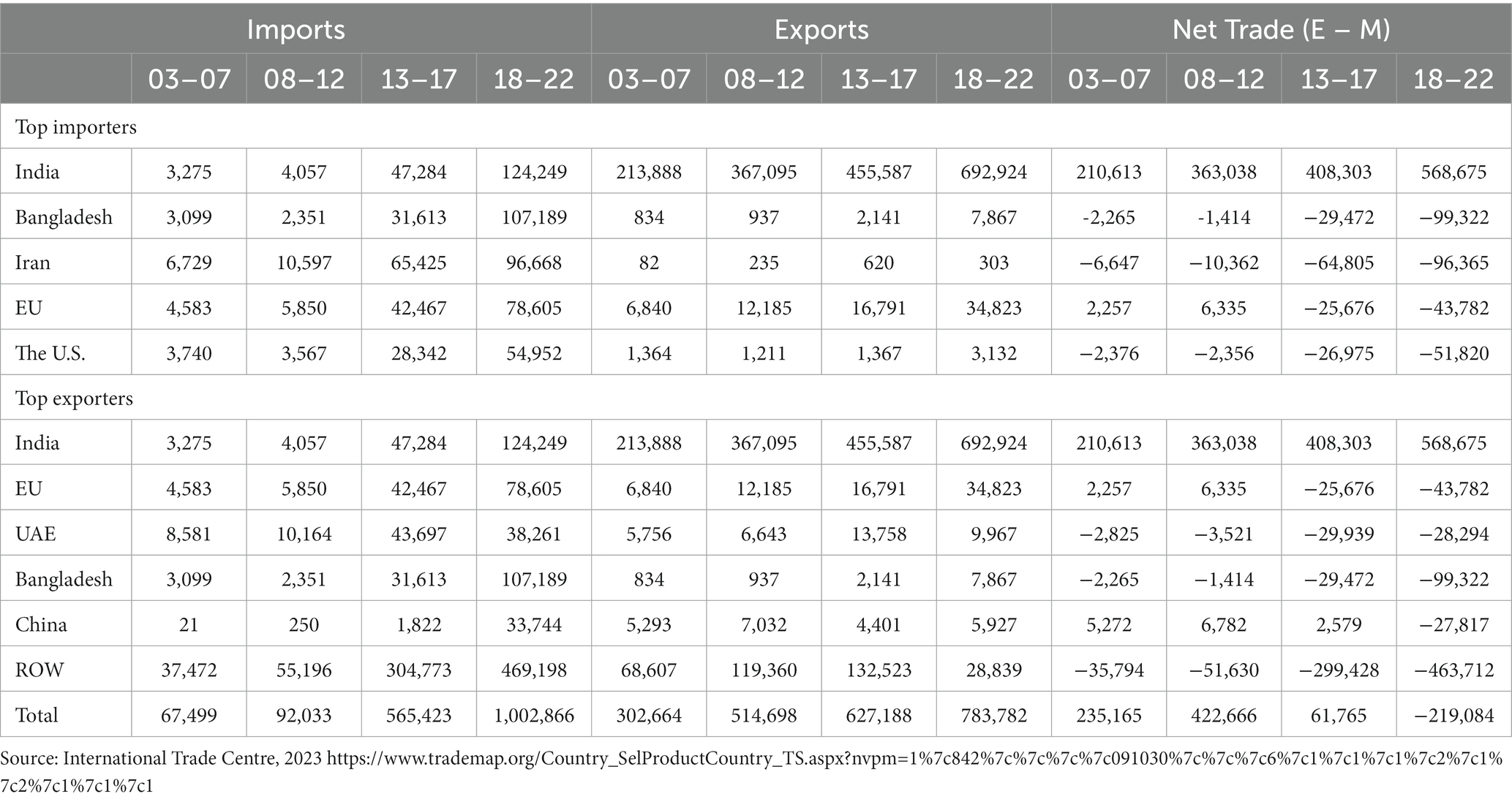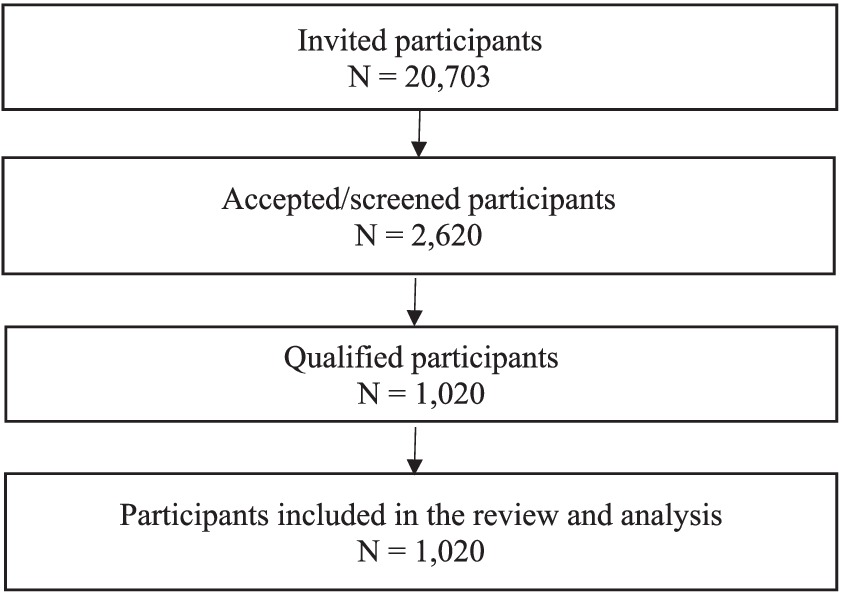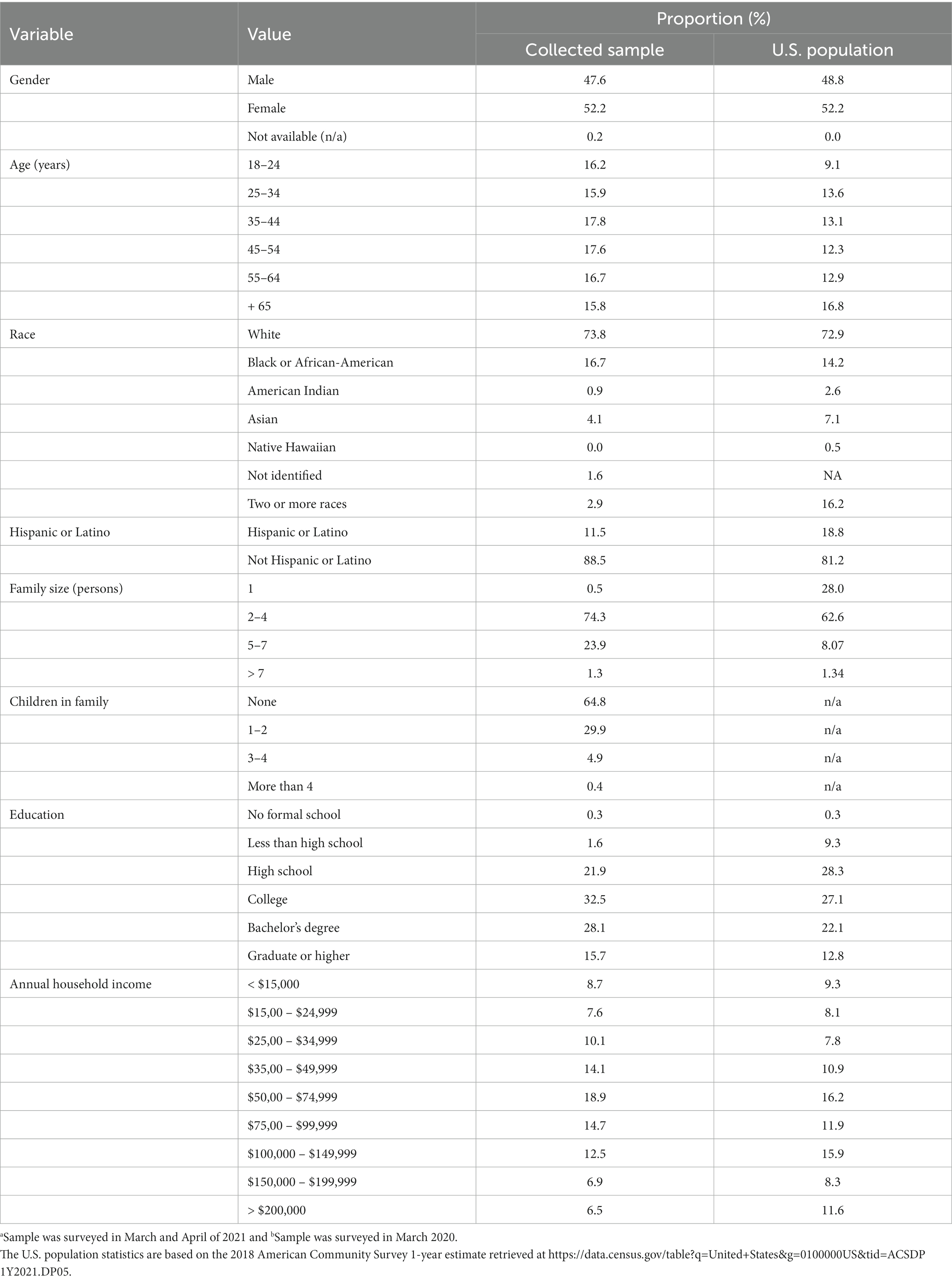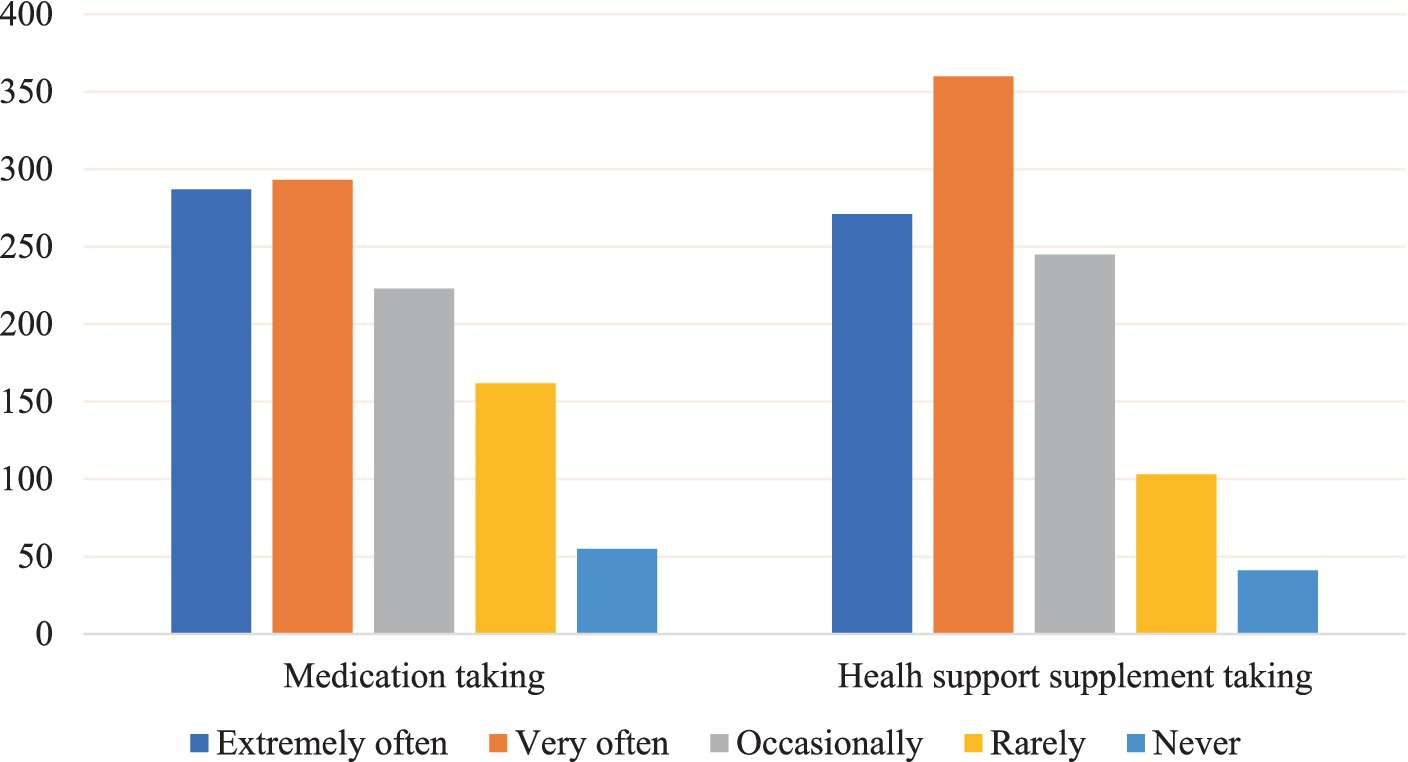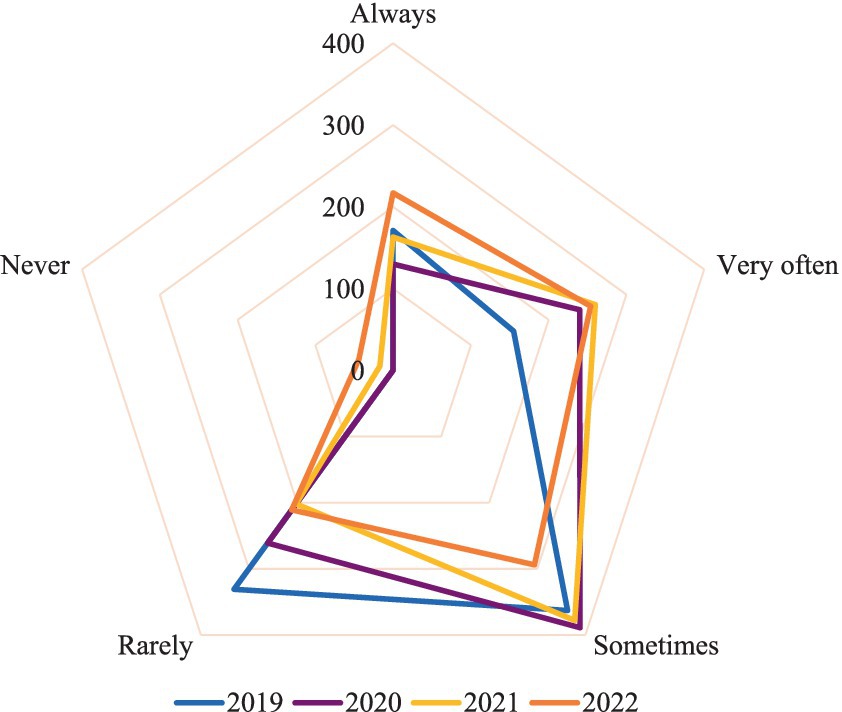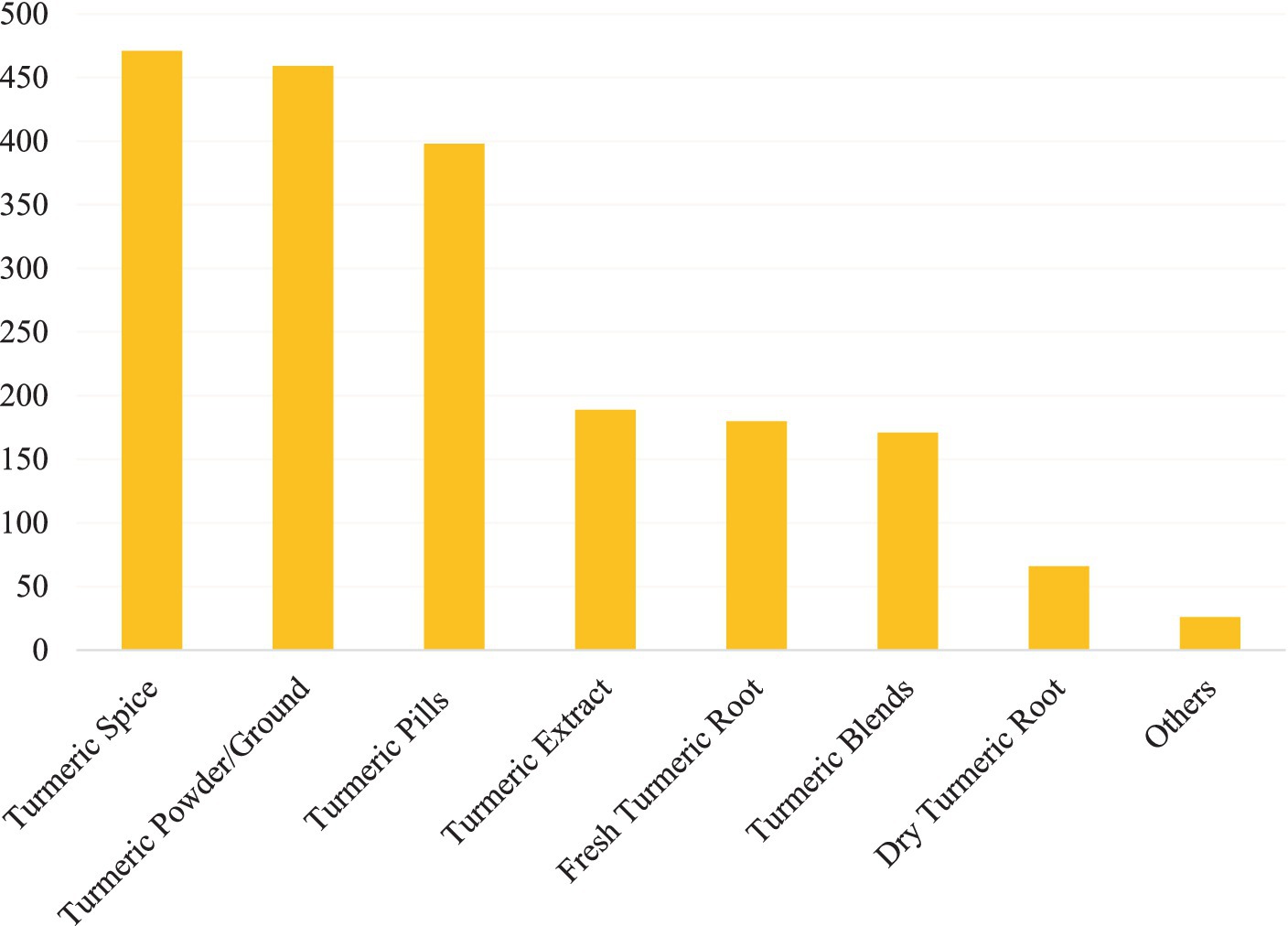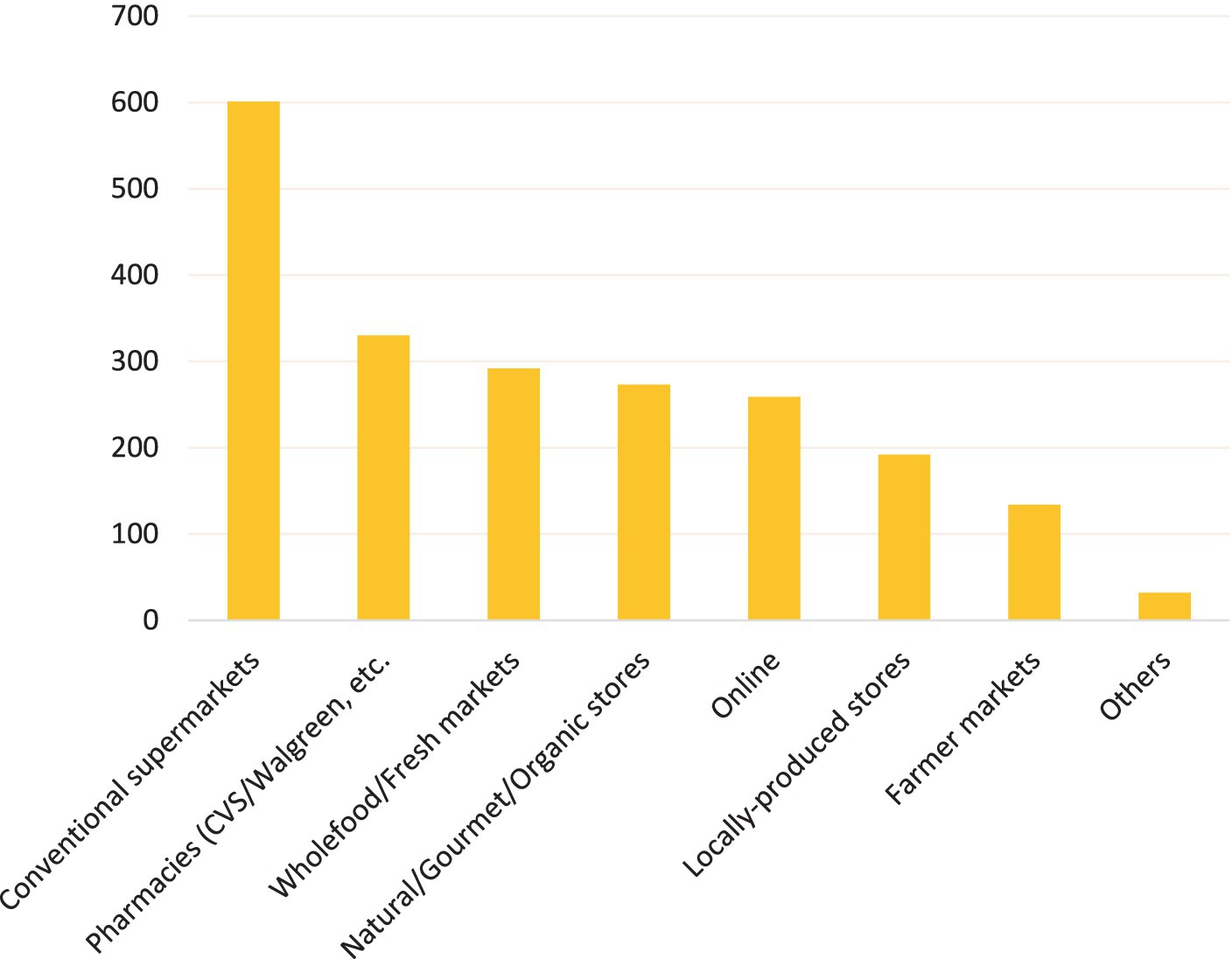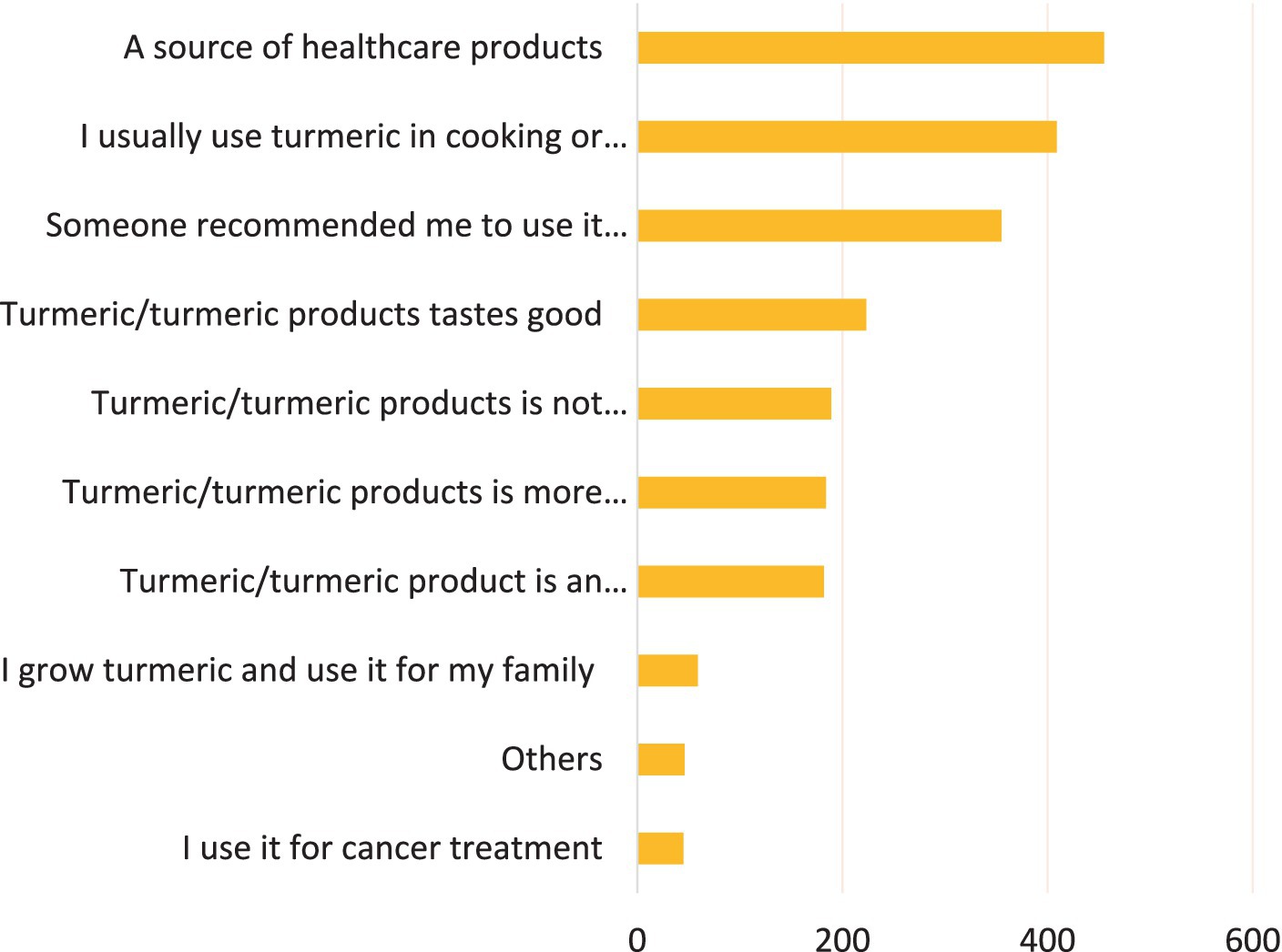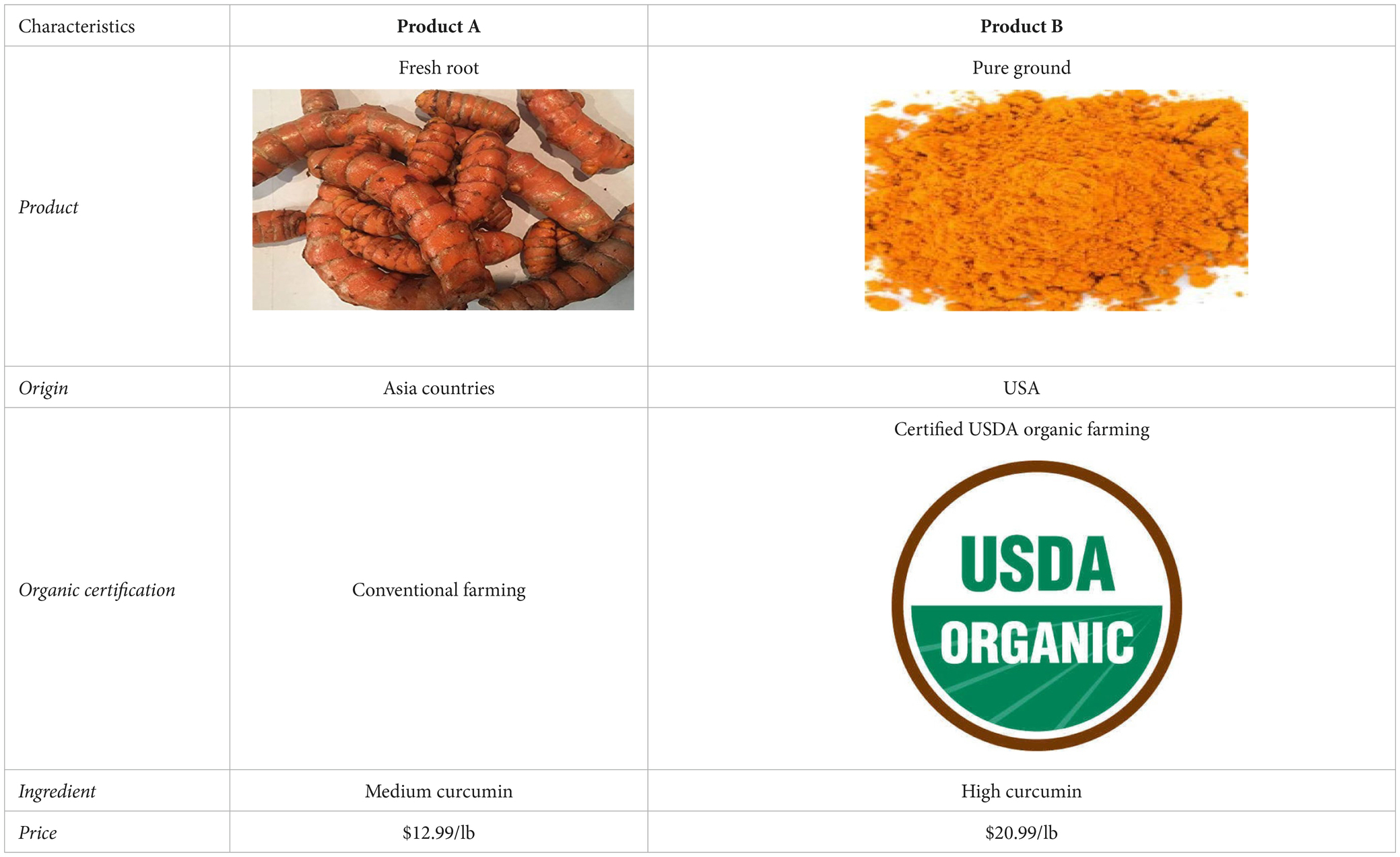Turmeric trends: analyzing consumer preferences and willingness to pay
- 1Agribusiness Program, College of Agriculture and Food Sciences, Florida A & M University, Tallahassee, FL, United States
- 2Rutgers, The State University of New Jersey, New Brunswick, NJ, United States
- 3Department of Natural Resources and Environmental Sciences, Alabama A & M University, Huntsville, AL, United States
This Research determines the factors influencing American consumers’ willingness to purchase turmeric products, amidst the spice’s rising popularity for its potential health benefits, particularly those linked to its bioactive component, curcumin. Through a comprehensive analysis of a Qualtrics online survey with 1,020 national respondents in the U.S., we employed advanced choice experiment mixed logit models to elucidate consumer preferences regarding product form, origin, sustainability certification, curcumin content, and price. Contrary to the initial hypothesis that curcumin potency would be a primary driver, our results indicate that the place of origin and price significantly shape purchasing decisions, with a clear preference for inland domestically grown, organically certified turmeric products. These insights offer valuable guidance for producers, manufacturers, and marketers in the natural products industry, suggesting a focus on emphasizing local, sustainable sourcing and clear communication of organic credentials to align with consumer expectations. Our findings not only provide a detailed understanding of current consumer attitudes toward turmeric but also highlight potential markets for turmeric–based product development and effective marketing to cater to the evolving demand for health-beneficial natural products.
1 Introduction
Turmeric (Curcuma longa), a herbaceous plant belonging to the ginger family, Zingiberaceae, is a rhizomatous crop valued for its extensive medicinal history, particularly due to its potent antioxidant, anti-inflammatory, and immunostimulatory properties (Bokelmann, 2022; Soni et al., 2022). The uses of turmeric span beyond merely foods and beverages; it is also renowned for its medicinal and cosmetic benefits. Therefore, the value chain of turmeric represents a complexity that distinguishes it from many other standard food or medical products (Booker et al., 2016).
Globally, turmeric is mainly used as a staple culinary spice in the South and a popular herbal remedy in the North. Turmeric is widely recognized as a food coloring and flavoring condiment and has been used as traditional medicine in many Asian countries. More recently, it has been adopted into Western medical and cosmetic practices, in which the United States (U.S.) is no exception.
In 2020, worldwide turmeric production was approximately 1.1 million metric tons (MT), with a projected 1.5 million MT by 2027 (GVR, 2021). The global trade value for turmeric in 2022 was $356.1 million (Trade Map ITC, 2023), and it is expected to grow at a compound annual growth rate of 16.1% up to 2028 (GVR, 2021). In the last decade, the leading exporters of turmeric were India, the European Union (EU), the United Arab Emirates (UAE), Bangladesh, and China, whereas the primary importers included India, Bangladesh, Iran, the EU, and the U.S. (Table 1). Interestingly, India stands out as not only the largest consumer but also the predominant producer of turmeric, contributing to 80% of the worldwide turmeric production volume (Nair, 2019).
Turmeric rhizome has been used over centuries to treat multiple human health conditions, including cancer,1 inflammation, kidney stones, worms, malaria, scabies, rheumatism, and to lower cholesterol levels (Lim et al., 2001; Rivera-Mancía et al., 2015; Kunnumakkara et al., 2017). It is also used for digestive disorders, flatus reduction, jaundice, menstrual difficulties and colic, and abdominal pain and distension (Bundy et al., 2004). The previous studies also showed that turmeric has well-established neuroprotective effects in the brain against ischemic damage, Alzheimer’s disease, Parkinson’s disease, and parathion-induced damage. Additionally, turmeric boosts heart health by protecting it against myocardia (Dikshit et al., 1995). Turmeric is also used to prevent kidney damage and kidney-related disorders by eliminating free radicals and reducing oxidative stress (Kunnumakkara et al., 2017).
In the U.S., turmeric is a top-selling dietary supplement and cosmetic with a rapidly expanding usage (You et al., 2022). Turmeric dietary products became a top-selling herb primary ingredient in the natural channel in the U.S. since 2013. The total sales value of herbal turmeric supplements increased from $25.6 million in 2013 to $151.7 million in 2021 (Smith et al., 2022). Turmeric, fresh or dry rhizomes, and curcumin-based products are now mainstream, with both dietary supplements and food and beverage products seeing market growth (Straus, 2019). Rising awareness among consumers, particularly in developed countries, including the U.S., will likely leverage the demand for turmeric curcumin further.2 Globally, 92 new turmeric-related products were introduced between 2018 and 2020 (Feldmeyer and Johnson, 2022), indicating a robust interest in turmeric’s medicinal and culinary applications. American consumers have recently shown a growing curiosity toward turmeric and its related products. As such, the Google search trends revealed an upward trajectory in the search frequency for the keywords, “turmeric” and “curcumin” since 2013 (Figure 2).
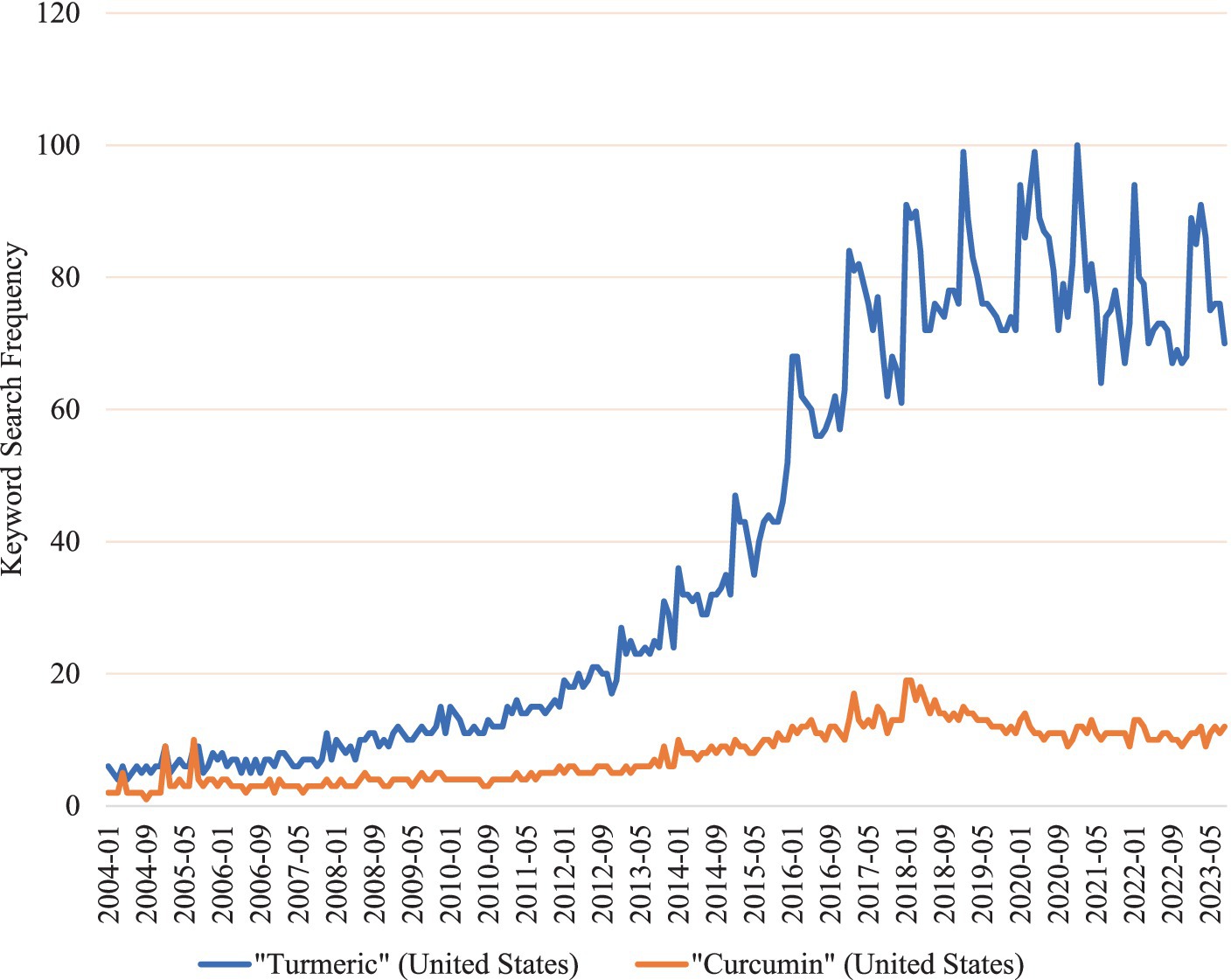
Figure 2. The trends of google search frequency of “turmeric” and “curcumin” in the U.S. from 1/2004 to 08/2023. Source: Google Trends, accessed July 2023 at https://trends.google.com/trends/.
The consumption of turmeric and turmeric-based products in the U.S. has recently increased, reflecting a shift in consumer tastes toward more natural food products and health or wellness supplements (International Food Information Council, 2023). Americans are increasingly seeking natural remedies and supplemental products, thereby boosting the turmeric market. Turmeric holds a significant rank in the U.S. dietary supplements market and is also a popular choice in spice markets and the fresh food sector (Nguyen et al., 2019). However, over 95% of the turmeric consumed in the U.S. is imported. In 2022, the U.S. spent approximately $50 million importing turmeric, of which 70% of these imports came from India, while the remaining was sourced mainly from Fiji, Jamaica, Indonesia, and China (Trade Map ITC, 2023). The demand for turmeric and turmeric products is anticipated to be propelled by its increasing application in numerous industries, including food and beverage, cosmetics, and pharmaceuticals (GVR, 2021).
Turmeric has shown promising pre-clinical effects on disease prevention and treatment (Zheng et al., 2016; Panknin et al., 2023) and has been explored clinically for a wide variety of human health conditions, from cancer to obesity and cardiovascular disease (Rolfe et al., 2020; Kunnumakkara et al., 2023). Curcumin, one of more than 200 ingredients in turmeric related to polyphenols comprising about 2–9% by weight on average of dried turmeric rhizome, is the primary constituent (Lechtenberg et al., 2004; Panknin et al., 2021). However, the curcumin content in turmeric rhizomes varies based on different factors such as turmeric variety (Quirós-Fallas et al., 2022), extraction methods (Patil et al., 2019; Quirós-Fallas et al., 2022; Singh et al., 2022; Ciuca and Racovita, 2023), rhizome age at harvest (Pantharos et al., 2022), geographical growth region (Ashraf et al., 2012), seasonal weather conditions (Lokhande et al., 2013), and cultivation methods (Shannon et al., 2019). Curcumin has applications in food, cosmetics, and pharmaceuticals, including dye-sensitized PV technology and textiles, and thus, its demand is projected to increase significantly in the next five years. The global curcumin marketing size reached $ 80.8 million in 2022, and it is expected to be $126.8 million in 2028 (IMARC, 2023). According to GVR (2021), curcumin-based pharmaceuticals have become a lucrative product valued at $65.4 million in 2021, and it is predicted to reach a market size of $191.9 million in 2028.
Curcumin is responsible for the yellow color of the powered rhizomes (Lechtenberg et al., 2004). Its efficacy, especially in treating human diseases related to metabolic disorders, musculoskeletal conditions, neuropsychiatric disorders, and gastrointestinal ailments, has been substantiated by eight systematic reviews and meta-analyses since 2020. These systematic analyses encompass over 400 research studies related to turmeric and turmeric-based products (Rolfe et al., 2020; Sharifi-Rad et al., 2020; Singletary, 2020; Paultre et al., 2021; Kou et al., 2023; Kunnumakkara et al., 2023; Lukkunaprasit et al., 2023; Panknin et al., 2023).
Globally, curcumin is applied in food and beverages, pharmaceuticals, and cosmetics, accounting for 90% of marketed volume (IMARC, 2023). Like other functional food products, the market success of curcumin depends mostly on the credibility of its beneficial effects on human health (Plasek and Temesi, 2019). While curcumin comprises only a minor fraction of turmeric, it is often the primary focus when discussing turmeric’s properties, to the extent that the terms “turmeric” and “curcumin” are used interchangeably, but they are different (Rolfe et al., 2020; Paultre et al., 2021; You et al., 2022). Furthermore, the quality of turmeric intended for medicinal or supplemental purposes is predominantly evaluated based on its curcumin content (Pantharos et al., 2022). As such, a higher curcumin content in turmeric suggests greater bioactivity and superior quality. Therefore, the higher the concentration of curcumin, the greater the value of the turmeric or turmeric products (Box, 1989).
However, the economic values of turmeric and curcumin in each turmeric product are still under-released. Specifically, understanding consumer perception and willingness to pay (WTP) for turmeric and turmeric curcumin ingredients has yet to be explored. Therefore, this research aims to determine consumer preferences and WTP for turmeric and turmeric ingredients in which curcumin content is our key interest. Moreover, transitioning from natural to synthetic curcumin in market products recently presents a challenge in maintaining turmeric quality and ensuring consumer trust. Based on lab tests of curcumin-related products randomly selected from the market, You et al. (2022) found that 10 of the 14 sampled products contained synthetic curcumin but were labeled natural. This adulteration forces consumers to pay more for curcumin products3 and can also put their health at risk. Consequently, insights into consumers’ WTP for turmeric products with natural curcumin content, as derived from this research, can provide marketers with valuable information to establish appropriate market prices that align with consumer demand for the product. Moreover, the curcumin content specified in this research can provide sufficient information for future discussion on the essential elements of labeling or transparency of curcumin level on turmeric-based products.
2 Literature review
Recent studies have explored consumer preferences and WTP for specific functional food ingredients. A review of 47 studies on functional products by Topolska et al. (2021) concluded that functional products’ credibility and potential health benefits—such as the prevention or treatment of certain diseases—are major factors influencing consumers’ purchasing decisions. In addition, Plasek and Temesi (2019), in their review of 54 studies, found that the compatibility of the carrier ingredient with the base product played a significant role in influencing the perceived health benefits and consumers’ willingness to purchase.
Current literature also shows a growth in exploring consumer perceptions and their willingness to purchase specific functional or health-beneficial ingredients. For example, Kleine-Kalmer et al. (2021) investigated consumer preferences and willingness to purchase selenium and iodine-biofortified apples. Although both ingredients are vital micronutrients, consumers preferred and were more willing to purchase apples fortified with iodine over selenium, it is because most consumers are unfamiliarity with selenium. Other studies have focused on consumer perceptions, preferences, and WTP for product ingredients like bread with varied fiber and salt content (Gębski et al., 2019), bread containing functional ingredients (Bitzios et al., 2011; Hellyer et al., 2012), probiotics in functional foods (Annunziata and Vecchio, 2013), low-sodium burgers (Quadros et al., 2015), and yogurt with bioactive functional ingredients (Ahmad et al., 2022).
However, to the best of our knowledge, research determining consumer perceptions and WTP for specific health-beneficial ingredients derived from herbal or related medicinal plants remains unexplored. Notable exceptions include the most recent study by Ndiaye et al. (2023) on hibiscus-based products and consumers WTP for non-alcoholic hibiscus beverages ranged from $2.9 to $3.6 for kombucha and $4.1–5.00 for ready-made-tea. However, their research concluded that providing additional health benefit information of hibiscus does not influence consumers WTPs for these products. Concerning turmeric, only research by Feldmeyer and Johnson (2022) using Twitter data to assess consumer responses to and perceived benefits of turmeric and turmeric-based products exists. However, this research is limited by the observed keywords associated with turmeric and turmeric products the consumers used in searching to determine consumers perceptions of its health benefit. Therefore, our study is based on consumer perceptions and their WTP for functional ingredients found in herbal plant products or specialty crops.
The growth in the import volume and value signals a growing demand for turmeric in the U.S. market (Figure 3). Yet, this heavy dependence on imports, particularly for food and pharmaceutical raw material supplements, raises quality and safety concerns, such as potential contamination with microorganisms, pesticide residues, heavy metals, and arsenic salts. For instance, the turmeric producers from India could add colorant in order to make their crop visually attractive to traders (Booker et al., 2016). The import prices of turmeric are varied due to a significant difference in quality standards between Asian countries and other competitors in the U.S. (Nguyen et al., 2019; Figure 4). Cultivating turmeric domestically could offer a more consistent and quality-controlled supply for the pharmaceutical and food and beverage industries and ensure stricter safety controls. While there have been experimental and commercial attempts to grow turmeric in states like Alabama and Georgia, these areas face challenges such as cold weather, high production costs, and labor-intensive practices.
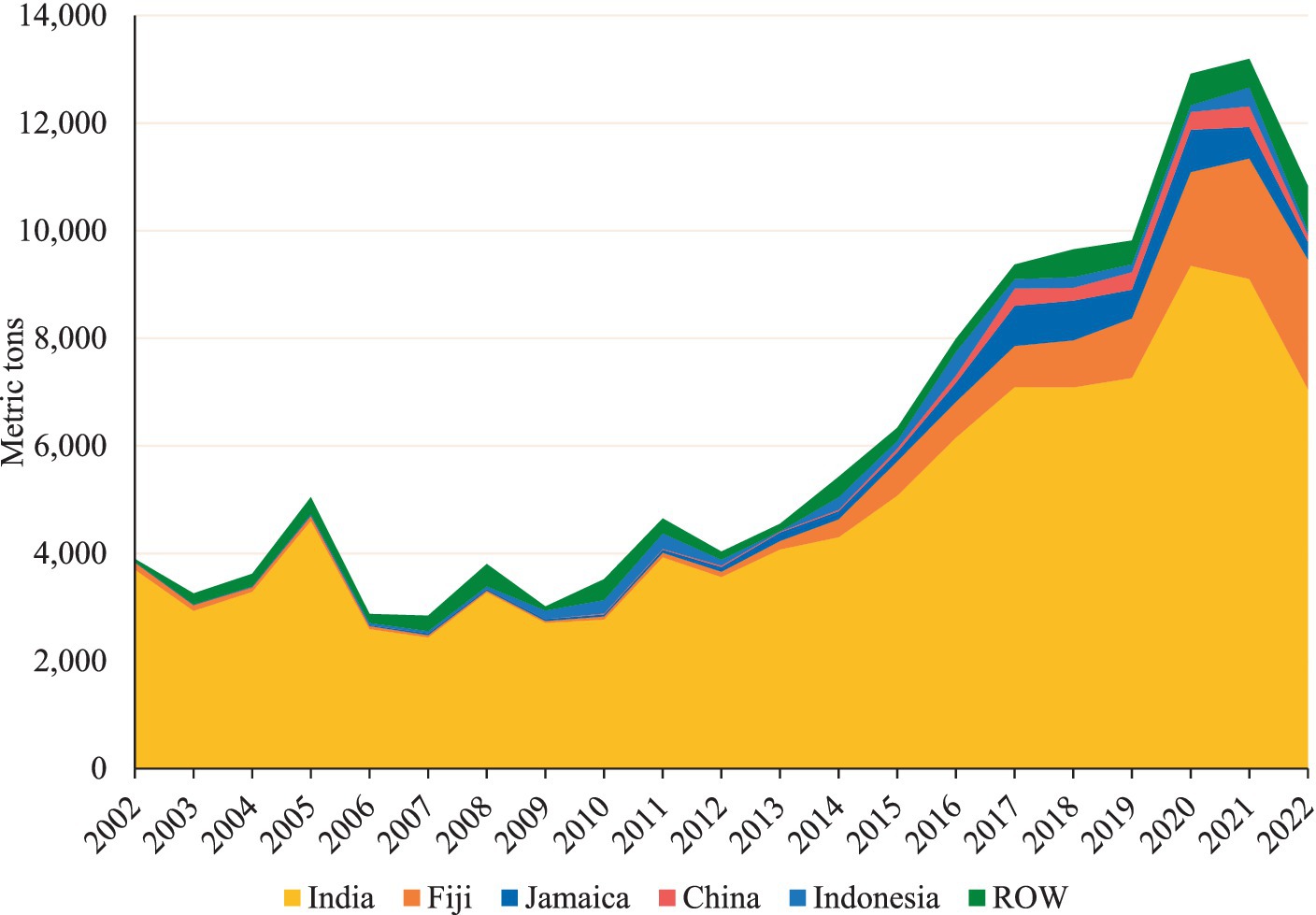
Figure 3. The major turmeric suppliers in the U.S. Market, 2002 to 2022 (imports in tons) Source: Trade Map ITC, 2023.
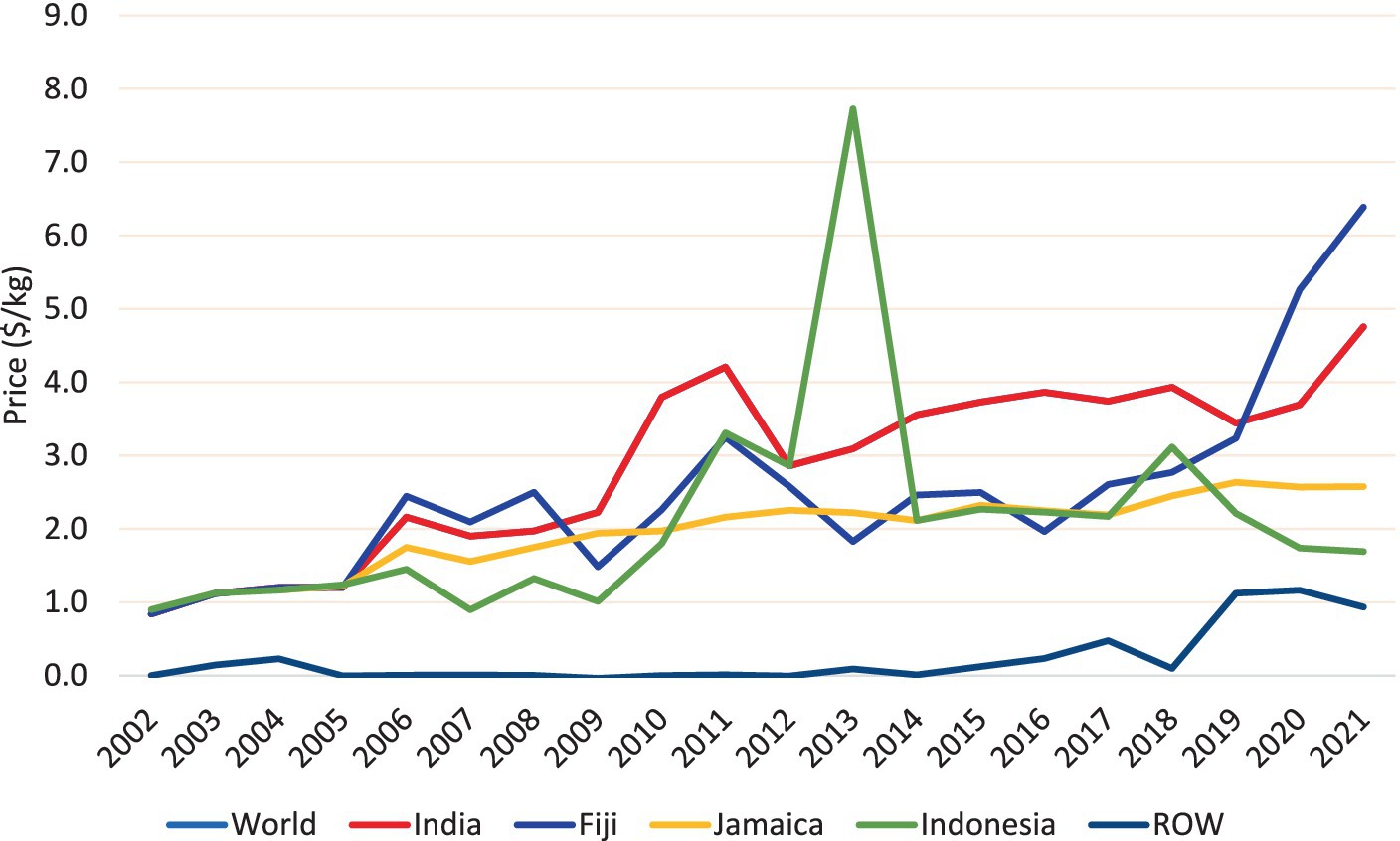
Figure 4. Per Unit Price ($/kg) of Turmeric the U.S. Imports from India and other countries (2002 – 2021) Source: Trade Map ITC, 2023.
Given its potential, turmeric could serve as a reliable specialty crop for the U.S., especially in the southern parts considering the suitable climatic conditions present in this region. The unfamiliarity of marketing and consumer preferences and their WTP for domestically grown turmeric remains a barrier for local farmers contemplating its cultivation. To address this, our research delves into various attributes of turmeric products, including product forms, place of origin, and sustainability certification. The U.S. herbal manufacturers are seeking domestically produced turmeric with high curcumin levels to replace imports (El-Saadony et al., 2023). Given that turmeric is increasingly being recognized as a trending ingredient in pharmaceuticals, beauty and personal care products, and nutritional drinks in the U.S. (Mintel, 2022), understanding consumer WTP for each of these product attributes is invaluable. This information can guide producers, processors, and marketers in shaping production plans, determining market values, and devising strategic marketing approaches to develop the domestic turmeric production effectively. Moreover, our findings can determine what consumers seek in turmeric products, potentially driving the creation of innovative turmeric-based pharmaceuticals, foods and beverages, and cosmetics tailored to the U.S. market.
With the rising trend of “food as medicine,” the National Strategy on Hunger, Nutrition, and Health envisions a seamless integration of nutrition and healthcare (Lynch, 2023). This aligns with the Food as Medicine Research Action Plan (Downer et al., 2022), which seeks to promote foods that offer significant health benefits. Given this context, gaining insights into consumers’ perceptions and their WTP for ingredients such as curcumin known to be essential or beneficial to human health becomes crucial. Moreover, consumers’ food preferences and eating habits are influenced by both genes and environment (Krebs, 2009), the findings from our research can shape effective marketing strategies that not only educate specific groups of consumers but also guide them in making informed choices of food and supplemental products. These choices would not only meet their nutritional needs but also assist in health issue prevention or treatment.
3 Materials and methods
3.1 Survey design and data collection
3.1.1 Survey design
An online survey was created using the Qualtrics platform to collect data on consumer perceptions and preferences related to turmeric products. The survey questionnaire comprises four sections. The first section includes questions related to respondents’ sociodemographic information, inquiring about their education level, household size, number of children in the household, race, and annual pre-tax income. The second section delves into consumers’ use of turmeric and turmeric products and the factors influencing their choice of these products. The third section involves a choice experiment aimed at eliciting consumer preferences for turmeric products. The final section collects consumer perceptions regarding the quality and curcumin content of organic and conventionally grown turmeric.
Before participants were asked to decide, a brief explanation of all attributes and their levels was provided. Additionally, a “cheap talk” script (Supplementary Appendix A) was employed prior to conducting the choice experiment. Specifically, participants were reminded of the “real world” decision-making process to potentially mitigate hypothetical bias in the choice experiment (Lusk, 2003; Silva et al., 2011). The survey was designed to be concise, each taking approximately 12 to 15 min to complete. No compensation was provided to participants for answering the questions.
The discrete choice experiment (DCE) was employed to examine consumers’ preferences for turmeric and turmeric products available at retail stores. The DCE method was chosen for this research due to its greater flexibility in incorporating additional food attributes compared to contingent valuation and experimental auction methods (Gao and Schroeder, 2009). Furthermore, DCE presents choices in a context that explicitly highlights trade-offs between attributes, and the choice scenarios simulate the conditions under which people make real-world choices (James and Burton, 2003).
The DCE was designed to prompt consumers to choose between two different turmeric products, denoted as products A and B, which vary in terms of five product attributes: product form, place of origin, sustainability certification, curcumin content, and per-unit price (Table 2). A complete factorial design would result in 360 (2x6x2x3x5) combinations of all attribute levels (Balogh et al., 2016). However, asking customers to decide on all these combinations is impractical. Therefore, we employed a fractional factorial design, following Addelman (1962).
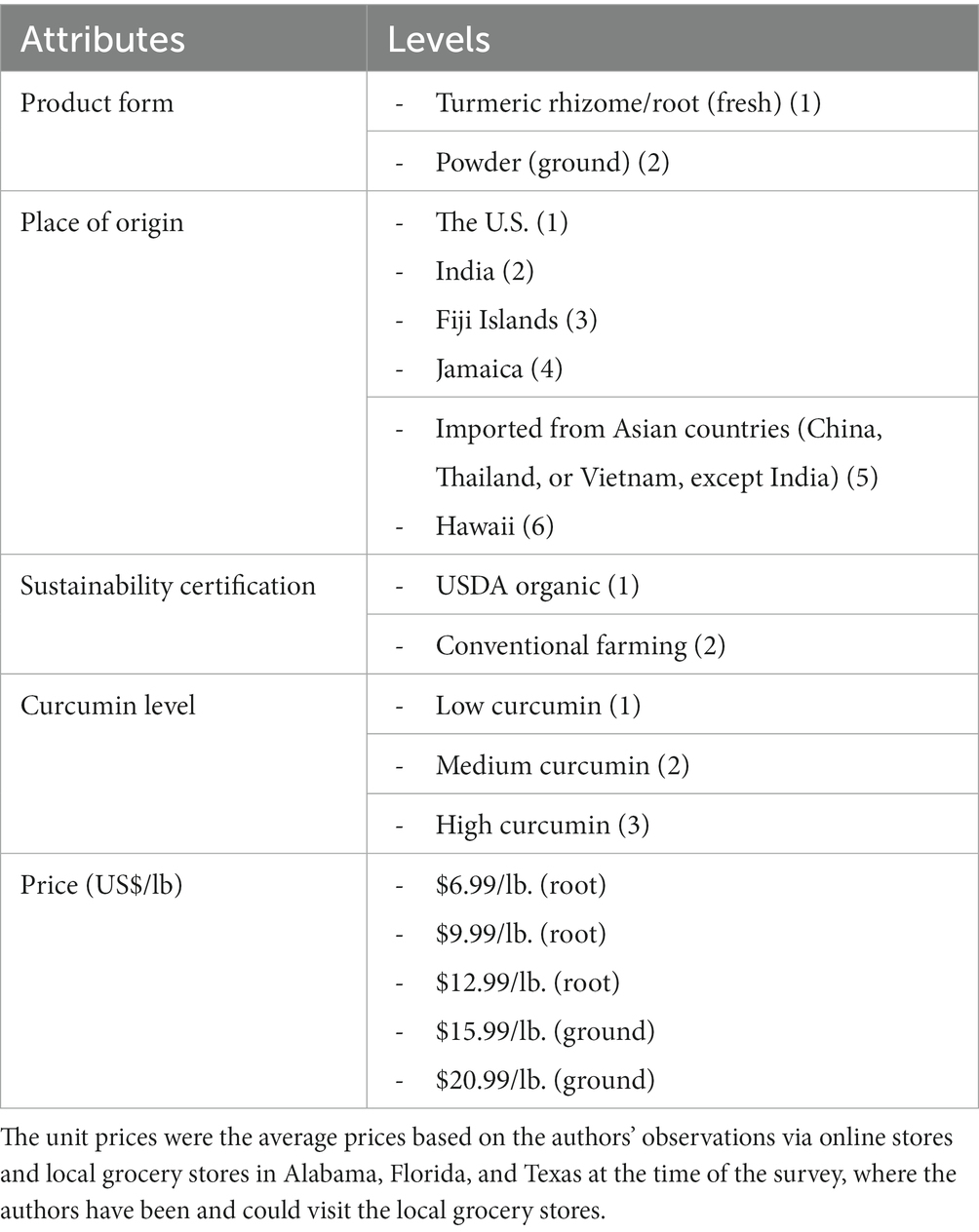
Table 2. The attributes and its levels of turmeric products used design the choice experiment questions.
To optimize the design, we selected D-efficiency as the relevant criterion, aiming to minimize the determinant of the inverse of the variance–covariance matrix (Hensher et al., 2005, p. 153). Consequently, the design yielded a choice experiment of 10 choice profiles that maximize D-efficiency using SAS software (Kuhfeld, 2010). These 10 choice sets were included in the survey for all participants, with each choice set presenting two turmeric products and a “neither product A nor product B” option. The inclusion of the “neither-choice option” enhances the realism of the choice experiment since, in reality, respondents may choose not to purchase any of the presented options (Vermeulen et al., 2008). An example of the choice questions is presented in Supplementary Appendix B.
3.1.2 Data collection
An online survey was implemented by the commercial survey firm Dynata, leveraging their diverse consumer panels (see their website: https://www.dynata.com/). These panels, composed of.
individuals from all 50 U.S. states who agreed to participate in online surveys and provided electronic consent prior to the study. The target demographic comprised U.S. adults aged 18 and above who are primarily responsible for grocery shopping (fulfilling at least 50% of the household’s monthly food requirements). In addition, qualified respondents must have purchased turmeric or turmeric products at least once since 2019.
The study received ethical approval from Rutgers, the State University of New Jersey Human Research Protection Program, and the Institutional Review Board (# IRB-Pro2021001641). The survey data was initially launched online from November 31 to December 1, 2022, for 50 samples for testing the survey. A full launch was implemented during December 12–19, 2022, receiving 1,020 completed responses from a total of 2,620 accepted participants (a response rate of 39%), which details are presented in the following chart. The selected participants form a representative sample of the U.S. civilian population. On average, respondents took 14 min to read and answer all the survey questions.
3.2 Modeling methods
The choice experiment model was used to analyze consumer preferences and elicit consumer WTP for different attributes of turmeric products based on Lancaster consumer theory (Lancaster, 1972) and random utility theory (McFadden, 1974). The ML model (or random parameter logit model), with a set of random and fixed parameters (Hensher and Greene, 2003; Hess and Train, 2017), was employed to account for potential heterogeneity of the preferences across individuals in the sample. In addition, the ML model relaxes the restriction of independence of irrelevant alternatives and allows for correlations between multiple-choice observations made by each respondent (Hensher and Greene, 2003; Bliemer and Rose, 2010) that allows for the estimation of unbiased individual preferences and increases the accuracy and reliability of the model estimations. Based on the random utility framework, the utility of an individual i associated with choice alternative j in the choice set C in situation t is specified as follows Eq. (1):
where is the continuous price of turmeric product j in the choice set C in situation t given to individual respondent i; vector X represents non-price attributes of j, or X = (product form (Form), place of origin (Origin), sustainability certification (Certificate), and curcumin content (Curcumin)); is an error component that is normally distributed, with zero mean.
The price coefficient, α1, is estimated as a nonrandom parameter. The coefficient of price is not random because the normal distribution has a density on both sides of zero that would allow some individuals to have upward-sloping demand curves (Hensher et al., 2005; Sarrias, 2016). This assumption assures that the WTP estimated for a particular turmeric attribute is normally distributed (Lusk, 2003; Tonsor et al., 2005) and avoids unrealistic WTP distributions associated with the ratio between two distributions (Carson and Czajkowski, 2019). Therefore, the price coefficient can be interpreted as the marginal utility of money (Onozaka and McFadden, 2011). The estimated coefficients of non-price attributes ( ) are defined as random parameters with a normal distribution where is the vector of the estimated conditional mean. L is the lower triangular matrix used to calculate the covariance of random parameters, and is the random term following a standard normal distribution. is the random terms capture variation in preferences across consumers over product attributes (Hensher et al., 2005; Hess and Train, 2017).
The probability of an individual i choosing alternative j in a sequence of t choices is as follows Eq. (2):
where is an indicator variable representing the section by individual i in the tth choice set. However, since can be heteroskedastic and correlated across alternatives, we need to integrate out this randomness. These yields Eq. (3):
where is specified as the joint distribution and is the distribution parameter of the corresponding attributes. The choice probability in (3) cannot be calculated exactly because the integral does not have a closed-form (Hensher and Greene, 2003). The integral is approximated through simulation (Hensher et al., 2005). The parameters in the ML model can be estimated using maximum simulated likelihood. Empirically, we used mlogit-package in R Studio version1.0–3 to estimate the mixed logit (ML) models using 1,000 Halton draws.
The “NONE” is a dummy variable indicating the third alternative of each choice set. This alternative represents the utility associated with the sum of the omitted levels for each attribute (Adamowicz et al., 1997; Soley et al., 2019). For the attributes of product form, fresh turmeric root is compared to ground power; The place of origin includes U.S. (inland), India, Fiji Island, Jamaica, Hawaii, and other Asian countries; sustainability is composed by USDA organic certificate vs. conventional farming; and the curcumin content is classified by three levels including low, medium, and high curcumin. Therefore, the parameter estimates of the levels of attributes indicate a preference for each attributes level and its baseline.
The individual-level WTP for each non-price attribute derived from the ML model is the negative of the ratio between the estimated parameter of a non-price attribute and the estimated price parameter. In particular, the WTP for the attribute k of a turmeric product is as follows Eq. (4):
where represents the monetary values that respondents are WTP to acquire a level-differentiated attribute, is the estimated coefficient of the attribute k, and is the estimated coefficient of price. The distribution of is derived from the expected distribution of and (Train, 2003). In this model, the price coefficient is fixed; therefore, the distribution of WTP for each non-price-level-differentiated attribute has the same distribution as the attribute’s coefficient. Similar to the random parameters of the non-price attributes, the mean and standard deviation of the WTP for each attribute level are estimated as Eqs. (5) and (6):
4 Results
4.1 Sample description
A comparison of the demographic characteristics between our collected sample and the U.S. population is presented in Table 3. Overall, the survey participants represent the U.S. population in gender, race, and educational level. There are some differences in age distribution, with the sample showing higher proportions in 18–24 age groups compared to the population. With the family size, our sample has a larger proportion of families with 2–4 persons compared to the U.S. population. The income levels of surveyed participants show some deviation in income levels compared to the U.S. population in which we have less proportion of respondents having the top income ranks.
Most respondents reported that they take medications and health support supplements occasionally or very often. The proportion of occasional users is relatively consistent across both medications and supplements, at 79 and 86%, respectively (Figure 5). Only a small percentage of respondents reported never using either; specifically, 5% for medications and 4% for health support supplements. Overall, the surveyed data show that respondents are generally inclined to use both medications and health supplements, regardless of the frequency of use. Additionally, 30% of respondents describe their overall health as “fair,” “not good,” or “very poor.” As such, a portion of medication or supplement use among these participants may be for prevention rather than treatment.
Approximately 64% of respondents indicate that they consciously look for turmeric or turmeric products while shopping at the stores or online. This suggests that businesses can target a large and aware consumer base with specialized or premium turmeric products. The frequency of turmeric or turmeric product purchases from 2019 to 2022 is presented in Figure 6. This data provides valuable insights into evolving consumer behavior, which is pertinent for both the turmeric industry and public health sectors. Overall, there is a noticeable increase in the frequency of turmeric purchases over time. Specifically, the categories ‘always’ and ‘very often’ have seen increased numbers, while the ‘rarely’ category has declined. This suggests a growing consumer interest in turmeric and its products over the years. Such a trend may indicate heightened awareness of turmeric’s health benefits, a notion that public health campaigns could further amplify. The emerging patterns provide actionable insights for both turmeric businesses and public health organizations. Continuous tracking and strategic adjustments are advisable for both sectors to cater to changing consumer needs and preferences.
Most participants indicate that their current health status influences their purchases of turmeric or turmeric products (Figure 7). Specifically, over 43% (extremely and very influential) are significantly influenced by their health status when purchasing turmeric. Thus, turmeric producers and suppliers can target this segment with health-focused marketing campaigns. Around 31% say health is ‘somewhat influential,’ companies could offer various product options focusing on health and other features like taste or convenience. Approximately 25% (slightly and not at all influential) are not significantly influenced by their health status. This group may respond better to marketing emphasizing flavor, traditional uses, or versatility in cooking or coloring.
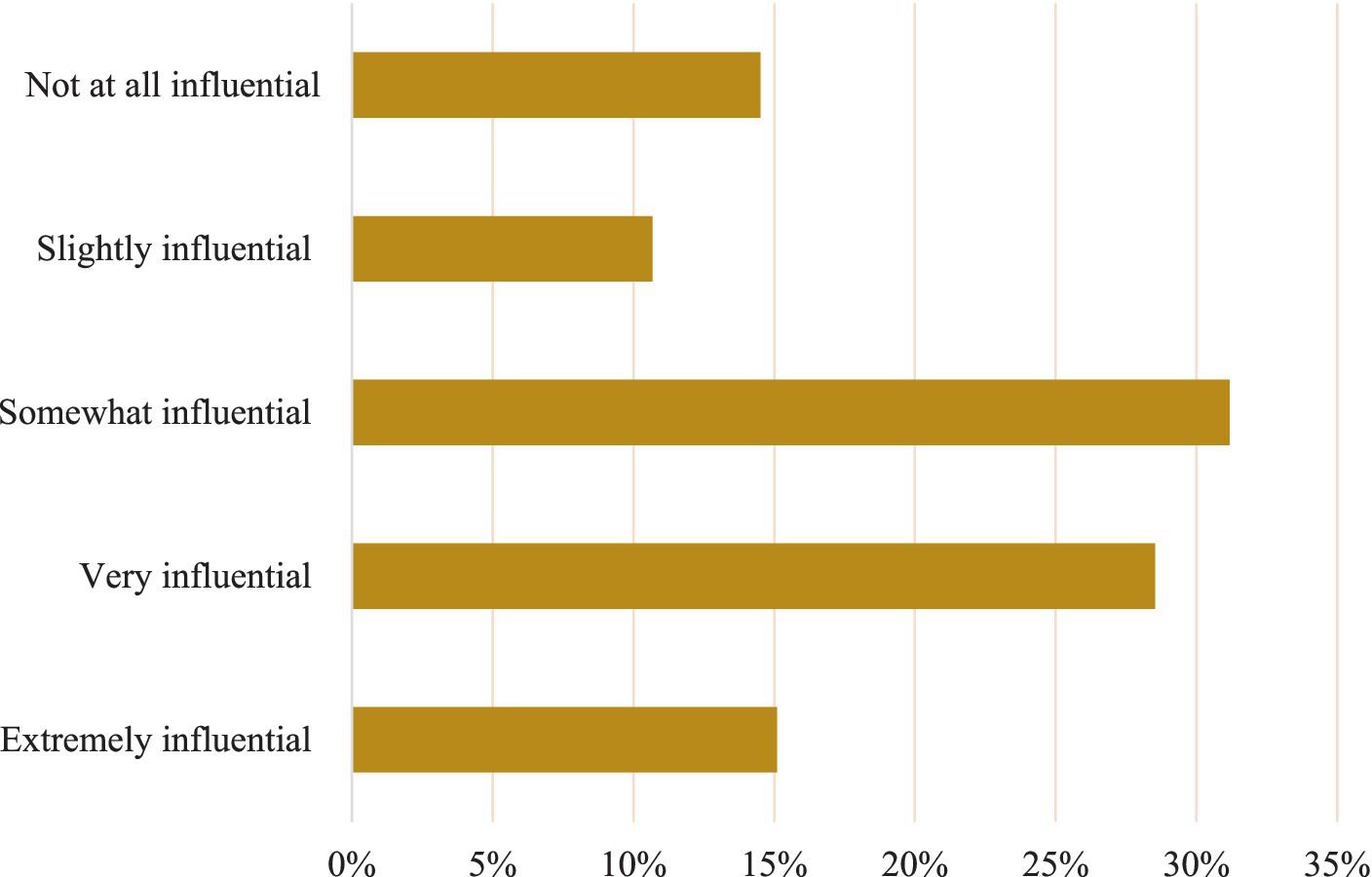
Figure 7. Consumers confirm whether their health status influences their purchase of turmeric (percentage of total respondents).
The participants were also asked to indicate the form of turmeric or turmeric products they purchase most frequently. The forms of turmeric and turmeric products most frequently used by respondents are presented in Figure 8. Turmeric spice, turmeric powder or ground, and turmeric pills make up nearly 68% of the usage. The most common uses of these products imply that consumers prefer forms that are easy to use and incorporate into their lives. Therefore, turmeric marketers can continue focusing on these forms due to their widespread popularity among American consumers. Turmeric extract, fresh turmeric root, and turmeric blends are used less frequently but still represent significant market segments. Specialized marketing could appeal to these users.
One of the questions in the survey explores consumer preferences on the place for purchasing turmeric and turmeric products. The data on where Americans primarily purchase turmeric and turmeric products are presented in Figure 9. Accordingly, conventional supermarkets are the most popular venue for purchasing turmeric products, capturing over 28% of buyers. Turmeric marketers looking to mass-market turmeric products may consider this channel significantly. Pharmacies and Whole Foods or Fresh Markets account for almost 30% of purchases, indicating a sizable, health-conscious market segment that can be targeted with specialized products. While 12.3% of respondents primarily buy online, this could be a growth area, particularly as e-commerce continues to gain traction.
Last but not least is understanding consumers’ reasons for purchasing or using turmeric or turmeric products. The largest segment (22.2%) purchases turmeric as a source of healthcare products (Figure 10). A sizable portion of respondents use turmeric products for healthcare and cancer treatment, indicating that health benefits drive consumer choices. This suggests that health benefits are a significant motivator for consumers, reflecting a trend in targeting health benefits products. A significant portion (20%) uses turmeric in cooking or for food coloring, indicating its important role in culinary practices. With a large number relying on recommendations, public health organizations could focus on educating healthcare providers or influencers within communities about the benefits and limitations of turmeric. About 8.9% of consumers choose turmeric because it is environmentally sustainable, signaling an emerging trend of eco-conscious consumerism.
4.2 Discrete choice models
The results presented in Table 4 illustrate the contribution of each attribute level to consumers’ preferences for turmeric and turmeric products, as estimated from an ML model. The variables of interest encompass place of origin, price, production certification, product form, and curcumin level. The coefficient for price is statistically significant at the 0.01% level, as anticipated. The negative sign signifies an inverse price-demand relationship in line with demand theory, indicating that an increase in the price of one alternative reduces the likelihood of choosing that alternative. This result is consistent with the previous research on functional food products, which indicates that similar to conventional foods, the price of products is a significant factor influencing consumers’ willingness to purchase (Cukelj et al., 2016; Romano et al., 2016; Plasek and Temesi, 2019).
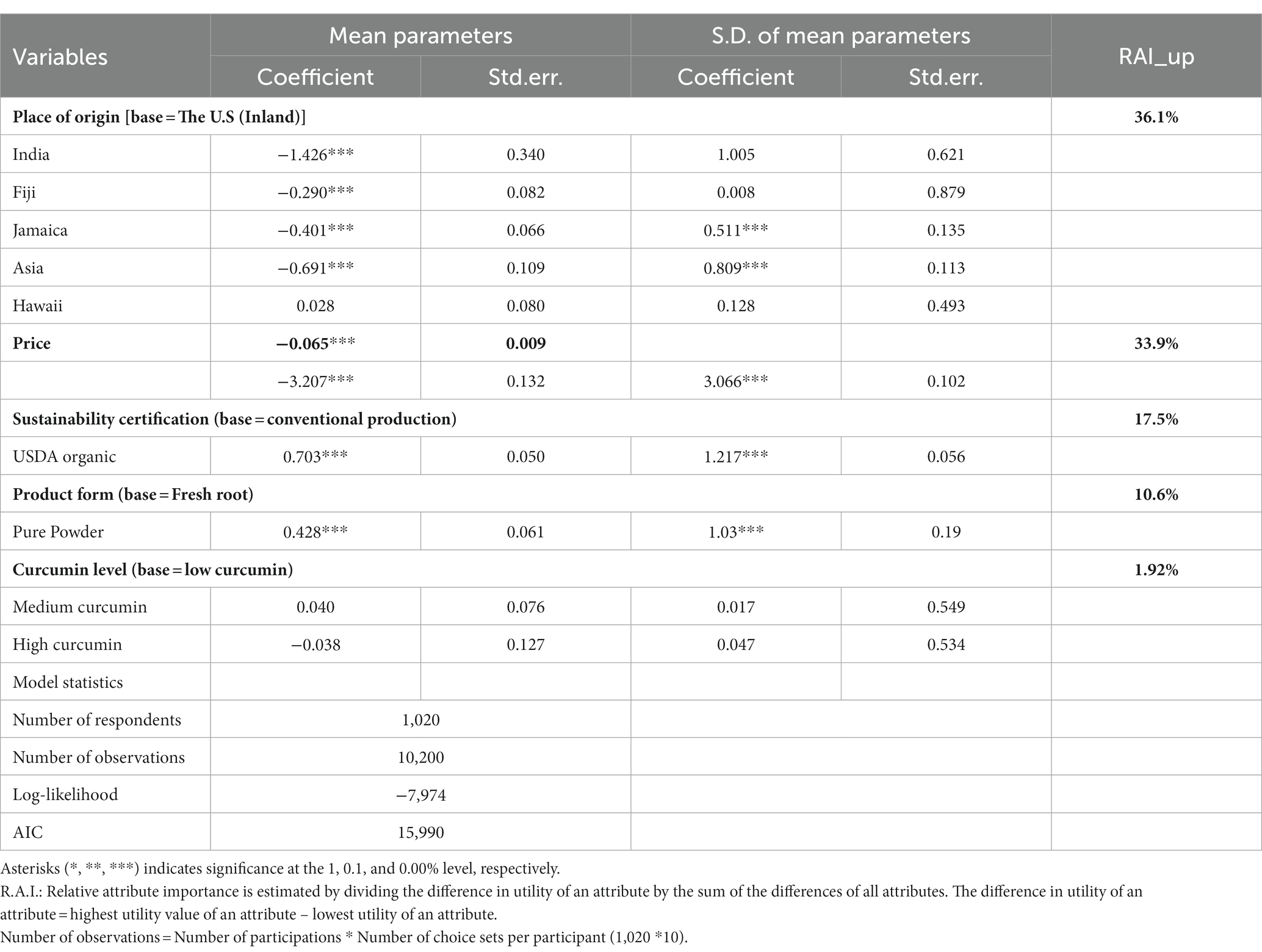
Table 4. Estimated parameters of the mixed logit models for consumers’ preferences on turmeric attributes.
Most non-price attribute coefficients are also statistically significant. Concerning the place of origin, the products produced in the U.S. inland were set as the base. The negative coefficients for India, Fiji, Jamaica, and Asia suggest that, on average, consumers prefer turmeric sourced from the U.S. The significance level (indicated by asterisks) confirms that these coefficients are statistically significant, ruling out the possibility of random chance. The positive coefficient for products from Hawaii suggests a preference for turmeric grown in Hawaii compared to the base level (U.S.). However, the attribute level lacks statistical significance, implying that while people might lean toward turmeric from Hawaii over that from the U.S., this preference is not sufficiently robust to state it as a fact. However, these results align with the research conducted by Onozaka and McFadden (2011), which demonstrated that Americans have a preference for locally grown Gala apples and red round tomatoes. Similarly, He et al. (2020) found that the place of origin is deemed more important than the production methods for strawberries. The positive and statistically significant coefficient for “organic” indicates that consumers are more inclined to prefer organically produced turmeric over conventionally grown turmeric. This result aligns with prior research on other food products, revealing that consumers favor sustainability-certified products over non-certified ones (Basha et al., 2015; McFadden and Huffman, 2017; Massey et al., 2018).
Regarding product form, consumers seem to favor pure powder over fresh root, as indicated by the positive and statistically significant coefficient. This aligns with the sample description section above, which suggests that consumers prefer forms that are convenient and ready to use. This information is valuable for producers and suppliers, highlighting the importance of providing these forms to meet consumer expectations. To the best of our knowledge, prior research evaluating the impact of product form on consumers’ WTPs for similar products has been limited, with notable exceptions being studies on meat (comparing fresh and processed meat) by Balcombe et al. (2016), and seafood (comparing fresh vs. frozen) by Zheng et al. (2023), Love et al. (2022), and Davidson et al. (2012). Therefore, this finding serves as a valuable reference for future studies concerning medicinal plants and functional food products.
Consumer preference for curcumin level is a key area of interest. The curcumin content in each turmeric product was classified into three levels: low, medium, and high, with low curcumin serving as the base in this model. The results indicate that neither medium nor high curcumin levels significantly impact consumer preference. This finding is consistent with research by Ndiaye et al. (2023), which revealed that there is no significant difference in consumers’ WTPs based on the health benefit indicators of hibiscus products. This could suggest that consumers may not be fully aware of the benefits associated with different curcumin levels in turmeric. While curcumin is the compound responsible for turmeric’s medicinal properties, as mentioned in the introduction, the lack of information might lead to indifference to consumer preference. However, it is worth noting that while curcumin levels do not significantly influence the average consumer, there may be niche markets, such as health enthusiasts or individuals with specific health conditions, who value this attribute. This presents a potential opportunity for market differentiation and further research to understand why curcumin levels do not influence consumer choice. It is essential to determine whether consumers are truly indifferent or simply unaware of the implications of different curcumin levels in turmeric and turmeric products. This understanding could open up new avenues for businesses and policymakers. In addition, consumers have shown a WTP for functional foods when health-related information is clearly displayed and communicated, as demonstrated by Oliveira et al. (2016). Through the analysis of 54 studies on functional food products and WTPs, Plasek and Temesi (2019) found that the determinants of consumers’ WTP and the perceived credibility of health benefits attributed to functional products are ambiguous. These factors can vary significantly based on the underlying product and its ingredients, the source of the health information, the design of the product, and the cultural background of the country in question.
Since the results from the ML model provide mean parameters indicating the impacts of each attribute level on consumer utility compared to the baseline of each attribute, we cannot directly compare the relative effect of each attribute on utility due to differences in unit and scale among the attributes (Lancsar and Louviere, 2008). Therefore, we calculate the relative importance of each attribute to determine its significance in consumer choice decisions. The relative importance of an attribute is estimated by dividing the difference in utility between the highest and lowest levels of a single attribute by the sum of the utility differences of all attributes (He et al., 2020). The results are presented in the last column of Table 4. Overall, the place of origin and price appear to be the most crucial factors, contributing to 36 and 34% of consumer choices for turmeric, respectively, while curcumin levels hold the least importance, accounting for only 2%. Mean marginal WTP and its associated confidence intervals are estimated for each attribute level (Equations 4, 5) based on the outputs from the ML models.
The marginal WTP per turmeric product with corresponding attribute levels is presented in Table 5. The WTP estimates offer consistent evidence regarding the importance of individual attribute levels, in line with the previously discussed relative importance of attributes. Specifically, consumers are WTP the most for organic turmeric, with a mean WTP of $10.9 per pound (lb.) and a narrow 95% confidence interval (9.97; 11.76), indicating strong confidence in this estimate. The second most valued attribute is “pure powder,” with a mean WTP of $6.70/lb. and a 95% confidence interval (5.69; 7.72). This suggests that consumers perceive value in the powdered form of the product. Despite “medium” being ranked third for curcumin content, the mean WTP is relatively low at just $0.61/lb. This premium value of turmeric is significantly lower than the organic attribute, implying that the curcumin content in turmeric is less valued than sustainable certification when consumers make purchasing decisions. Turmeric from Hawaii has a low but positive mean WTP of $0.44/lb. This suggests some preferences, albeit not strong, as indicated in the ML model.
Interestingly, the high level of curcumin has a negative mean WTP of -$0.58/lb., implying that consumers might actually prefer to avoid products with high curcumin levels, perhaps due to price considerations or a lack of awareness regarding its benefits. Turmeric from Fiji, Jamaica, Asia, and India all have negative WTP, with India being the least preferred. This suggests that consumers may have reservations about the quality or source of turmeric from these places than products produced in the U.S.
In summary, consumers place the highest value on organic and pure powdered forms of turmeric, likely due to perceptions of quality, safety, or effectiveness. Curcumin levels do not appear to strongly influence WTP, underscoring the potential benefits of educational efforts if curcumin content is deemed a meaningful quality metric. Place of origin significantly impacts consumer choices, suggesting a need for quality assurance or improved marketing for turmeric products from countries other than the U.S. This could pave the way for potential growth in domestic turmeric production.
5 Concluding comments
The demand for turmeric and turmeric-based products has surged in the U.S., reflecting an increasing interest among Americans in natural products with health benefits. This research confirms that consumers are incorporating more turmeric and turmeric products into their lives due to health concerns and the desire for health supplements. Consumer preferences and WTP for turmeric and its products in the U.S. are influenced and shaped by multiple factors. Consumers’ choices of turmeric are impacted by product prices, the place of origin, sustainability certification, and product forms. Notably, the level of curcumin content in turmeric is not a significant factor, suggesting that public awareness regarding the importance of curcumin levels may be limited, and this awareness is not necessarily translating into purchasing decisions. This result aligns with previous research by Ndiaye et al. (2023), which indicates that the health benefits of a product do not influence consumers’ WTP if it is unfamiliar to them.
Our results confirm the importance of the organic attribute such as “organic” and “pure powder” significantly influence consumer choices and WTP. Additionally, the product’s geographical origin significantly impacts consumer preferences, with a preference for domestic turmeric and a negative preference for turmeric sourced from India, Asia, Fiji, and Jamaica. This suggests concerns about the quality or safety of the product based on its origin, requiring attention from both industry stakeholders and public health agencies to better inform consumers about the place of origin of turmeric and turmeric products.
This research provides valuable insights into the evolving consumer attitudes and WTP for turmeric products, serving as an important resource for both the industry and policymakers. The goal is to align more effectively with public preferences and health needs. These results could prove invaluable for manufacturers and marketers of turmeric products, enabling them to comprehend consumer priorities better and tailor their products and messaging accordingly. However, it is essential to acknowledge the limitations of this study. The number of respondents constrains the research and lacks detailed information to fully explain consumer perceptions regarding ingredients in turmeric other than curcumin. Therefore, further research is recommended to understand why curcumin levels do not significantly influence consumer choices and explore consumer perceptions of other turmeric ingredients. Understanding the reasons behind the lack of impact of curcumin levels on consumer preferences could provide critical information for businesses and policymakers. This, in turn, could lead to the formulation of appropriate policies to improve consumer knowledge and support healthier choices.
The results imply areas where marketing and educational campaigns could be effectively targeted. For instance, if curcumin content is a meaningful indicator of product quality or efficacy, better consumer education about its benefits could be beneficial. Similarly, enhancing the reputation of turmeric in the U.S. compared to other countries with less favorable WTP could be a pivotal strategy for developing domestic turmeric production. The findings offer actionable insights into which product attributes to emphasize in marketing efforts for businesses operating in the turmeric industry. Certifying products as organic could be a worthwhile investment given consumer WTP for this attribute. Furthermore, this information could also prove invaluable for new product development and optimizing existing product lines.
In summary, this research provides valuable insights into the evolving consumer attitudes and WTP for turmeric products, serving as an important resource for both the industry and policymakers. The goal is to align more effectively with public preferences and health needs. These results could prove invaluable for manufacturers and marketers of turmeric products, enabling them to better comprehend consumer priorities and develop products and messaging accordingly. However, it is essential to acknowledge the limitations of this study. The number of respondents constrains the research and lacks detailed information to fully explain consumer perceptions regarding ingredients in turmeric other than curcumin. Therefore, further research is recommended to understand why curcumin levels do not significantly influence consumer choices and explore consumer perceptions of other turmeric ingredients. Understanding the reasons behind the lack of impact of curcumin levels on consumer preferences could provide critical information for businesses and policymakers. This, in turn, could lead to the formulation of appropriate policies to improve consumer knowledge and support healthier choices.
Data availability statement
The collected data via survey will be made available upon request.
Ethics statement
The studies involving humans were approved by the Rutgers, the State University of New Jersey Human Research Protection Program, and the Institutional Review Board (# IRB-Pro2021001641) on 10/05/2021. The studies were conducted in accordance with the local legislation and institutional requirements. Written informed consent for participation in this study was provided by the participants’ legal guardians/next of kin. Written informed consent was obtained from the individual(s) for the publication of any potentially identifiable images or data included in this article.
Author contributions
LY: Data curation, Writing – original draft, Writing – review & editing. RG: Conceptualization, Data curation, Resources, Supervision, Writing – review & editing. SM: Formal analysis, Funding acquisition, Investigation, Resources, Supervision, Validation, Writing – review & editing.
Funding
The author(s) declare that financial support was received for the research, authorship, and/or publication of this article. The findings and conclusions in this publication are those of the author(s), data for this study were collected by researchers at Rutgers, the State University of New Jersey. Ethical approval for the involvement of human subjects in this study was granted by Rutgers, the State University of New Jersey Human Research Protection Program, and the Institutional Review Board (# IRB-Pro2021001641) on 10/05/2021, and this material is based upon work supported by the U.S. Department of Agriculture (USDA) National Institute of Food and Agriculture, Agricultural Food Research Initiative (AFRI) project number 2020–67023-30979.
Conflict of interest
The authors declare that the research was conducted in the absence of any commercial or financial relationships that could be construed as a potential conflict of interest.
Publisher’s note
All claims expressed in this article are solely those of the authors and do not necessarily represent those of their affiliated organizations, or those of the publisher, the editors and the reviewers. Any product that may be evaluated in this article, or claim that may be made by its manufacturer, is not guaranteed or endorsed by the publisher.
Footnotes
1. ^The most recent research by Soni et al. (2022) indicates that Curcumin, the yellow pigment of turmeric spice, has shown effective cytotoxic activity against numerous malignant cells, including hepatic cancer.
2. ^Although curcumin can be found in other species such as mango ginger (Srinivasan and Chandrasekhara, 1993), this study focuses exclusively on curcumin derived from turmeric rhizomes.
3. ^According to Bejar (2018), synthetic curcumin is priced at one-third the cost of its natural counterpart.
References
Adamowicz, W., Swait, J., Boxall, P., Louviere, J., and Williams, M. (1997). Perceptions versus objective measures of environmental quality in combined revealed and stated preference models of environmental valuation. J. Environ. Econ. Manag. 32, 65–84. doi: 10.1006/jeem.1996.0957
Ahmad, I., Hao, M., Li, Y., Zhang, J., Ding, Y., and Lyu, F. (2022). Fortification of yogurt with bioactive functional foods and ingredients and associated challenges - a review. Trends Food Sci. Technol. 129, 558–580. doi: 10.1016/j.tifs.2022.11.003
Addelman, S. (1962). Symmetrical and asymmetrical fractional plans. Technometrics 4, 47–58. doi: 10.1080/00401706.1962.10489986
Annunziata, A., and Vecchio, R. (2013). Consumer perception of functional foods: a conjoint analysis with probiotics. Food Qual. Prefer. 28, 348–355. doi: 10.1016/j.foodqual.2012.10.009
Ashraf, K., Mujeeb, M., Ahmad, A., Mohd Amir, M., Mallick, N., and Sharma, D. (2012). Validated HPTLC analysis method for quantification of variability in content of curcumin in Curcuma Longa L (turmeric) collected from different geographical region of India. Asian Pac. J. Trop. Biomed. 2, S584–S588. doi: 10.1016/S2221-1691(12)60278-0
Balcombe, K., Bradley, D., Fraser, I., and Hussein, M. (2016). Consumer preferences regarding country of origin for multiple meat products. Food Policy 64, 49–62. doi: 10.1016/j.foodpol.2016.09.008
Balogh, P., Békési, D., Gorton, M., Popp, J., and Lengyel, P. (2016). Consumer willingness to pay for traditional food products. Food Policy 61, 176–184. doi: 10.1016/j.foodpol.2016.03.005
Basha, M. B., Mason, C., Shamsudin, M. F., Hussain, H. I., and Salem, M. A. (2015). Consumers attitude towards organic food. Proced. Econom. Fin. 31, 444–452. doi: 10.1016/S2212-5671(15)01219-8
Bejar, E. (2018). Turmeric (Curcuma longa) Root and Rhizome, and Root Rhizome Extracts. A Report by American Botanical Council.
Bitzios, M., Fraser, I., and Haddock-Fraser, J. (2011). Functional ingredients and food choice: results from a dual-mode study employing means-end-chain analysis and a choice experiment. Food Policy 36, 715–725. doi: 10.1016/j.foodpol.2011.06.004
Bliemer, M. C. J., and Rose, J. M. (2010). Construction of experimental designs for mixed logit models allowing for correlation across choice observations. Transp. Res. B Methodol. 44, 720–734. doi: 10.1016/j.trb.2009.12.004
Bokelmann, J. M. (2022). “Turmeric (Curcuma Longa)” in Medicinal herbs in primary care (Elsevier), 615–636.
Booker, A., Johnston, D., and Heinrich, M. (2016). The welfare effects of trade in phytomedicines: a multi-disciplinary analysis of turmeric production. World Dev. 77, 221–230. doi: 10.1016/j.worlddev.2015.08.024
Box, H. (1989). Developments in the spices trade: a review. Br. Food J. 91, 15–18. doi: 10.1108/EUM0000000002302
Bundy, R., Walker, A. F., Middleton, R. W., and Booth, J. (2004). Turmeric extract may improve irritable bowel syndrome symptomology in otherwise healthy adults: a pilot study. J. Altern. Complement. Med. 10, 1015–1018. doi: 10.1089/acm.2004.10.1015
Carson, R. T., and Czajkowski, M. (2019). A new baseline model for estimating willingness to pay from discrete choice models. J. Environ. Econ. Manag. 95, 57–61. doi: 10.1016/j.jeem.2019.03.003
Cukelj, N., Putnik, P., Novotni, D., Ajredini, A., Voucko, B., and Curic, D. (2016). Market potential of lignans and Omega-3 functional cookies. Br. Food J. 118, 2420–2433. doi: 10.1108/BFJ-03-2016-0117
Ciuca, M. D., and Racovita, R. C. (2023). Curcumin: overview of extraction methods, health benefits, and encapsulation and delivery using microemulsions and Nanoemulsions. Int. J. Mol. Sci. 24:8874. doi: 10.3390/ijms24108874
Davidson, K., Pan, M., Hu, W., and Poerwanto, D. (2012). Consumers' willingness to pay for aquaculture fish products vs. Wilde-caught seafood - a case study in Hawaii. Aquac. Econ. Manag. 16, 136–154. doi: 10.1080/13657305.2012.678554
Dikshit, M., Rastogi, L., Shukla, R., and Srimal, R. C. (1995). Prevention of ischaemia-induced biochemical changes by curcumin & quinidine in the cat heart. Indian J. Med. Res. 101, 31–35.
Downer, S., Clippinger, E., Kummer, C., and Hager, K. (2022). Food is Medicine Research Action Plan. Food & Society Aspen Institute Available at: https://www.aspeninstitute.org/wp-content/uploads/2022/01/Food-is-Medicine-Action-Plan-Final_012722.pdf
El-Saadony, M. T., Yang, T., Korma, S. A., Sitohy, M., Abd, T. A., El-Mageed, S. S., et al. (2023). Impacts of turmeric and its principal bioactive curcumin on human health: pharmaceutical, medicinal, and food applications: a comprehensive review. Front. Nutr. 9:1040259. doi: 10.3389/fnut.2022.1040259
Feldmeyer, A., and Johnson, A. (2022). Using twitter to model consumer perception and product development opportunities: a use case with turmeric. Food Qual. Prefer. 98:104499. doi: 10.1016/j.foodqual.2021.104499
Gao, Z., and Schroeder, T. C. (2009). Effects of label information on consumer willingness-to-pay for food attributes. Am. J. Agric. Econ. 91, 795–809. doi: 10.1016/j.foodqual.2019.03.012
Gębski, J., Jezewska-Zychowicz, M., Szlachciuk, J., and Kosicka-Gębska, M. (2019). Impact of Nutritional Claims on Consumer Preferences for Bread with Varied Fiber and Salt Content. Food Qual Prefer. 76, 91–99. doi: 10.1111/j.1467-8276.2009.01259.x
GVR (2021). Curcumin market size, share & trends analysis report by application (pharmaceutical, food, cosmetics), by region (North America, Europe, Asia Pacific, Central & South America, Middle East & Africa). And Segment Forecasts, 2021–2028.
He, C., Shi, L., Gao, Z., and House, L. (2020). The impact of customer ratings on consumer choice of fresh produce: a stated preference experiment approach. Can. J. Agricul. Econom. 68, 359–373. doi: 10.1111/cjag.12222
Hellyer, N. E., Fraser, I., and Haddock-Fraser, J. (2012). Food choice, health information and functional ingredients: an experimental auction employing bread. Food Policy 37, 232–245. doi: 10.1016/j.foodpol.2012.02.005
Hensher, D. A., and Greene, W. H. (2003). The mixed logit model: the state of practice. Transportation 30, 133–176. doi: 10.1023/A:1022558715350
Hensher, D. A., Rose, J. M., and Greene, W. H. (2005). Applied choice analysis: a primer Cambridge university press, New York.
Hess, S., and Train, K. (2017). Correlation and scale in mixed logit models. J. Choice Model. 23, 1–8. doi: 10.1016/j.jocm.2017.03.001
International Market Analysis Research and Consulting Group (IMARC Group). (2023). Food and Beverages (F&B) Coding and Marking Equipment Market Report. Available at: https://www.imarcgroup.com/food-beverages-coding-marking-equipment-market (Accessed September 2023).
International Food Information Council. (2023). Food & Health Survey. Available at: https://foodinsight.org/2023-food-and-health-survey/
James, S., and Burton, M. (2003). Consumer preferences for GM food and other attributes of the food system. Aust. J. Agric. Resour. Econ. 47, 501–518. doi: 10.1111/j.1467-8489.2003.t01-1-00225.x
Kleine-Kalmer, R., Profeta, A., Daum, D., and Enneking, U. (2021). Pre-launch exploration of consumer willingness to purchase selenium- and Lodine-biofortified apples-a discrete choice analysis of possible marketing settings. Nutrients 13:1625. doi: 10.3390/nu13051625
Kou, H., Huang, L., Jin, M., He, Q., Zhang, R., and Ma, J. (2023). Effect of curcumin on rheumatoid arthritis: a systematic review and meta-analysis. Front. Immunol. 14:1121655. doi: 10.3389/fimmu.2023.1121655
Krebs, J. (2009). The gourmet ape: evolution and human food preferences. Am. J. Clin. Nutr. 90, 707S–711S. doi: 10.3945/ajcn.2009.27462B
Kuhfeld, W.F. (2010). Marketing research methods in S.A.S.: experimental design, choice, conjoint, and graphical techniques. SAS 9.2 ed. S.A.S. Institute, Cary, NC. Available at: https://support.sas.com/techsup/technote/mr2010.pdf
Kunnumakkara, A. B., Bordoloi, D., Padmavathi, G., Monisha, J., Roy, N. K., Prasad, S., et al. (2017). Curcumin, the Golden nutraceutical: multitargeting for multiple chronic diseases: curcumin: from kitchen to clinic. Br. J. Pharmacol. 174, 1325–1348. doi: 10.1111/bph.13621
Kunnumakkara, A. B., Hegde, M., Parama, D., Girisa, S., Kumar, A., Daimary, U. D., et al. (2023). Role of turmeric and curcumin in prevention and treatment of chronic diseases: lessons learned from clinical trials. ACS Pharmacol. Transl. Sci. 6, 447–518. doi: 10.1021/acsptsci.2c00012
Lancsar, E., and Louviere, J. (2008). Conducting discrete choice experiments to inform healthcare decision making: a user guide. PharmacoEconomics 26, 661–677. doi: 10.2165/00019053-200826080-00004
Lechtenberg, M., Quandt, B., and Nahrstedt, A. (2004). Quantitative determination of curcuminoids InCurcuma rhizomes and rapid differentiation OfCurcuma domestica Val. AndCurcuma Xanthorrhiza Roxb. By capillary electrophoresis. Phytochem. Anal. 15, 152–158. doi: 10.1002/pca.759
Lim, G. P., Chu, T., Yang, F., Beech, W., Frautschy, S. A., and Cole, G. M. (2001). The curry spice curcumin reduces oxidative damage and amyloid pathology in an Alzheimer transgenic mouse. J. Neurosci. 21, 8370–8377. doi: 10.1523/JNEUROSCI.21-21-08370.2001
Lokhande, S. M., Kale, R. V., Sahoo, A. K., and Ranveer, R. C. (2013). Effect of curing and drying methods on recovery, curcumin and essential oil content of different cultivars of turmeric (Curcuma Longa L). Int. Food Res. J. 20, 745–749. Available at: https://doi.org/10.1590/1678-4324-2021200697
Love, C. D., Thorne-Lyman, A. L., Conrad, Z., Gepart, J. A., Asche, F., Goso-Solo, D., et al. (2022). Afforability influences nutritional quality of seafood consumption among income and race/ethnicity groups in the united sates. Am. J. Clin. Nutr. 116, 415–425. doi: 10.1093/ajcn/nqac099
Lukkunaprasit, T., Tansawet, A., Boonmanunt, S., Sobhonslidsuk, A., McKay, G. J., Attia, J., et al. (2023). An updated meta-analysis of effects of curcumin on metabolic dysfunction-associated fatty liver disease based on available evidence from Iran and Thailand. Sci. Rep. 13:5824. doi: 10.1038/s41598-023-33023-3
Lusk, J. L. (2003). Effects of cheap talk on consumer willingness-to-pay for Golden Rice. Am. J. Agric. Econ. 85, 840–856. doi: 10.1111/1467-8276.00492
Lynch, C. J. (2023). A concept for comprehensive food is medicine networks or Centers of excellence. Am. J. Clin. Nutr. 118, 10–12. doi: 10.1016/j.ajcnut.2023.04.027
Massey, M., O’Cass, A., and Otahal, P. (2018). A meta-analytic study of the factors driving the purchase of organic food. Appetite 125, 418–427. doi: 10.1016/j.appet.2018.02.029
McFadden, D. (1974). “Conditional logit analysis of qualitative choices P” in Frontiers in econometrics. ed. Zarembka (New York: Academic Press), 105–142.
McFadden, J. R., and Huffman, W. E. (2017). Willingness-to-pay for natural, organic, and conventional foods: the effects of information and meaningful labels. Food Policy 68, 214–232. doi: 10.1016/j.foodpol.2017.02.007
Nair, K.P. (2019). Turmeric (Curcuma longa L.) and ginger (Ziniger officinale Rosc.) - World's invaluable medicinal species: the agronomy and economy of turmeric and ginger. Springer nature Switzerland AG. 2019.
Ndiaye, O., Hedrick, V. E., Neill, C. L., Carneiro, R. C. V., Huang, H., Fernandez-Fraguas, C., et al. (2023). Consumer responses and willingness-to-pay for hibiscus products: a preliminary study. Front. Sustain. Food Syst. 7:1039203. doi: 10.3389/fsufs.2023.1039203
Nguyen, M., Duong, L. T., and Mentreddy, R. S. (2019). The U.S. Import Demand for Spices and Herbs by Differentiated Sources. J. Appl. Res. 12, 13–20.
Oliveira, L. D., Machín, R., Deliza, R., Rosenthal, A., Walter, E. H., Giménez, A., et al. (2016). Consumers' attention to functional food labels: insights from eye-tracking and change detection in a case study with probiotic Milk. LWT-Food Sci. Technol. 68, 160–167. doi: 10.1016/j.lwt.2015.11.066
Onozaka, Y., and McFadden, D. T. (2011). Does local Labeling complement or compete with other sustainable labels? A conjoint analysis of direct and joint values for fresh produce claim. Am. J. Agric. Econ. 93, 693–706. doi: 10.1093/ajae/aar005
Panknin, T., Bucchireddigari, B., Howe, C., Hauer, M., Rossi, A., and Funk, J. (2021). Curcumin-containing turmeric dietary supplement clinical trials: a scoping review. Curr. Dev. Nutr. 5:357. doi: 10.1093/cdn/nzab037_067
Panknin, T. M., Howe, C. L., Hauer, M., Bucchireddigari, B., Rossi, A. M., and Funk, J. L. (2023). Curcumin supplementation and human disease: a scoping review of clinical trials. Int. J. Mol. Sci. 24:4476. doi: 10.3390/ijms24054476
Pantharos, P., Sukcharoen, P., Phadungrakwittaya, R., Akarasereenont, P., Booranasubkajorn, S., and Lumlerdkij, N. (2022). Utilization of UPLC-PDA and GC–MS/MS coupled with metabolomics analysis to identify bioactive metabolites in medicinal turmeric at different ages for the quality assurance. Phytomedicine 102:154157. doi: 10.1016/j.phymed.2022.154157
Patil, S. S., Bhasarkar, S., and Rathod, V. K. (2019). Extraction of curcuminoids from Curcuma Longa: comparative study between batch extraction and novel three phase partitioning. Prep. Biochem. Biotechnol. 49, 407–418. doi: 10.1080/10826068.2019.1575859
Paultre, K., Cade, W., Hernandez, D., Reynolds, J., Greif, D., and Best, T. M. (2021). Therapeutic effects of turmeric or curcumin extract on pain and function for individuals with knee osteoarthritis: a systematic review. BMJ Open Sport Exerc. Med. 7:e000935. doi: 10.1136/bmjsem-2020-000935
Plasek, B., and Temesi, Á. (2019). The credibility of the effects of functional food products and consumers’ willingness to purchase/willingness to pay– review. Appetite 143:104398. doi: 10.1016/j.appet.2019.104398
Quadros, D. A., De, I. F., Rocha, D. O., Ferreira, S. M. R., and Bolini, H. M. A. (2015). Low-sodium fish burgers: sensory profile and drivers of liking. LWT Food Sci. Technol. 63, 236–242. doi: 10.1016/j.lwt.2015.03.083
Quirós-Fallas, M. I., Vargas-Huertas, F., Quesada-Mora, S., Azofeifa-Cordero, G., Wilhelm-Romero, K., Vásquez-Castro, F., et al. (2022). Polyphenolic HRMS characterization, contents and antioxidant activity of Curcuma Longa rhizomes from Costa Rica. Antioxidants 11:620. doi: 10.3390/antiox11040620
Rivera-Mancía, S., Lozada-García, M. C., and Pedraza-Chaverri, J. (2015). Experimental evidence for curcumin and its Analogs for Management of Diabetes Mellitus and its Associated Complications. Eur. J. Pharmacol. 756, 30–37. doi: 10.1016/j.ejphar.2015.02.045
Rolfe, V., Mackonochie, M., Mills, S., and MacLennan, E. (2020). Turmeric / curcumin and health outcomes: a meta-review of systematic reviews. Eur. J. Integr. Med. 40:101252. doi: 10.1016/j.eujim.2020.101252
Romano, R. K., Finco, F. D. B. A., Rosenthal, A., Finco, M. V. A., and Deliza, R. (2016). Willingness to pay more for value-added pomegranate juice (Punica granatum L.): an open-ended contingent valuation. Food Res. Int. 89, 359–364. doi: 10.1016/j.foodres.2016.08.039
Sarrias, M. (2016). Discrete choice models with random parameters in R: the Rchoice package. J. Stat. Softw. 74, 1–31. doi: 10.18637/jss.v074.i10
Shannon, D. A., Santen, E., Salmasi, S. Z., Murray, T. J., Duong, L. T., Greenfield, J. T., et al. (2019). Shade, establishment method, and varietal effects on rhizome yield and curcumin content in turmeric in Alabama. Crop Sci. 59, 2701–2710. doi: 10.2135/cropsci2019.04.0262
Sharifi-Rad, J., El Rayess, Y., Rizk, A. A., Sadaka, C., Zgheib, R., Zam, W., et al. (2020). Turmeric and its major compound curcumin on health: bioactive effects and safety profiles for food, pharmaceutical, biotechnological and medicinal applications. Front. Pharmacol. 11:01021. doi: 10.3389/fphar.2020.01021
Silva, A., Nayga, R. M., Campbell, B. L., and Park, J. L. (2011). Revisiting cheap talk with new evidence from a field experiment. J. Agric. Resour. Econ. 36, 280–291. Available at: https://www.jstor.org/stable/23243081
Singh, K., Srichairatanakool, S., Chewonarin, T., Prommaban, A., Samakradhamrongthai, R. S., Brennan, M. A., et al. (2022). Impact of green extraction on curcuminoid content, antioxidant activities and anti-cancer efficiency (in vitro) from turmeric rhizomes (Curcuma Longa L.). Food Secur. 11:3633. doi: 10.3390/foods11223633
Smith, T., Resetar, H., and Morton, C. (2022). U.S. sales of herbal supplements increase by 9.7% in 2021. American botanical council. 2021 herb market report. Available at: (http://vitaminretailer.com/u-s-herbal-supplement-sales-increased-by-9-7-percent-in-2021/#:~:text=Annual%20sales%20of%20herbal%20dietary,ABC’s)%202021%20Herb%20Market%20Report.)
Singletary, K. (2020). Turmeric: potential health benefits. Nutr. Today 55, 45–56. doi: 10.1097/NT.0000000000000392
Soley, G., Wuyang, H., and Vassalos, M. (2019). Willingness to pay for shrimp with homegrown by heroes, community-supported fishery, Best aquaculture practices, or local attributes. J. Agric. Appl. Econ. Nagaraju, G.P., Ahmad, S., Eds.; Cambridge, MA, USA: Academic Press, 2022 51, 606–621. doi: 10.1017/aae.2019.19
Soni, V. K., Ratre, Y. K., Mehta, A., Dixit, A. K., Dwivedi, M., Shukla, D., et al. (2022). “Curcumin: a spice pigment against hepatic cancer” in Theranostics and precision medicine for the management of hepatocellular carcinoma, vol. 3 (Elsevier), 141–159.
Srinivasan, M. R., and Chandrasekhara, N. (1993). Effect of Mango Ginger on Triton WR-1339 Induced-Hyperlipidemia and Plasma Lipases Activity in the Rat. Nutrition Research. 13, 1183–1190. doi: 10.1016/S0271-5317(05)80742-0
Straus, M. (2019). Turmeric time: new product launches. Nutritional Outlook. Available at: https://www.nutritionaloutlook.com/view/turmeric-time-new-product-launches
Tonsor, G. T., Schroeder, T. C., Fox, J. A., and Biere, A. (2005). European preferences for beef steak attributes. J. Agri. Resour. Econ. 30, 367–380. Available at: https://www.jstor.org/stable/40988077
Topolska, K., Florkiewicz, A., and Filipiak-Florkiewicz, A. (2021). Functional food—consumer motivations and expectations. Int. J. Environ. Res. Public Health 18:5327. doi: 10.3390/ijerph18105327
Vermeulen, B., Goos, P., and Vandebroek, M. (2008). Models and optimal designs for conjoint choice experiments including a no-choice option. Int. J. Res. Mark. 25, 94–103. doi: 10.1016/j.ijresmar.2007.12.004
You, H., Gershon, H., Goren, F., Xue, F., Kantowski, T., and Monheit, L. (2022). Analytical strategies to determine the labelling accuracy and economically motivated adulteration of ‘natural’ dietary supplements in the marketplace: turmeric case study. Food Chem. 370:131007. doi: 10.1016/j.foodchem.2021.131007
Zheng, Q., Nayga, R. M. Jr., Yang, W., and Tokunaga, K. (2023). Do U.S. consumers value genetically modified farmed Salmon? Food Qual. Prefer. 107:104841. doi: 10.1016/j.foodqual.2023.104841
Zheng, J., Zhou, Y., Li, Y., Xu, D.-P., Li, S., and Li, H.-B. (2016). Spices for prevention and treatment of cancers. Nutrients 8:495. doi: 10.3390/nu8080495
Appendix A
A.1. A cheap talk script was used in the only survey
“The following questions ask you to make your turmeric selection. When answering the following questions, please make sure that your choice in this survey is what you would make in a real-world purchase at present. There is a total of 10 consecutive scenarios. Please make your selection in each scenario independently. Please also keep in mind that your choice made in each of the following scenarios may reduce the budget for your other purchases should you make such a decision in real life.”
Appendix B
B.1. An example of the choice experiment questions used in the online survey
What will you purchase at a grocery store?
О Product A
О Product B
О Neither Product A nor Product B
Keywords: turmeric, curcumin, health benefit, perception, willingness to pay
Citation: Nguyen L, Govindasamy R and Mentreddy SR (2024) Turmeric trends: analyzing consumer preferences and willingness to pay. Front. Sustain. Food Syst. 8:1359040. doi: 10.3389/fsufs.2024.1359040
Edited by:
Isabelle Piot-Lepetit, INRAE Occitanie Montpellier, FranceReviewed by:
Renata Carneiro, Virginia Tech, United StatesSiphe Zantsi, Agricultural Research Council of South Africa, South Africa
Copyright © 2024 Nguyen, Govindasamy and Mentreddy. This is an open-access article distributed under the terms of the Creative Commons Attribution License (CC BY). The use, distribution or reproduction in other forums is permitted, provided the original author(s) and the copyright owner(s) are credited and that the original publication in this journal is cited, in accordance with accepted academic practice. No use, distribution or reproduction is permitted which does not comply with these terms.
*Correspondence: Ly Nguyen, ly.nguyen@famu.edu
 Ly Nguyen
Ly Nguyen Ramu Govindasamy
Ramu Govindasamy Srinivasa R. Mentreddy3
Srinivasa R. Mentreddy3